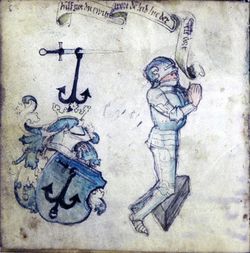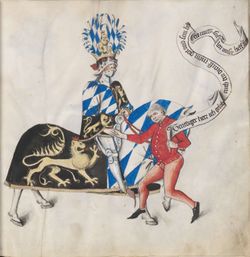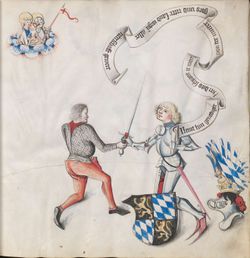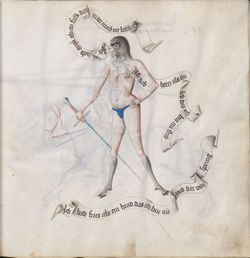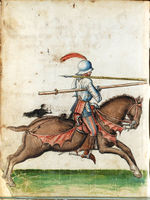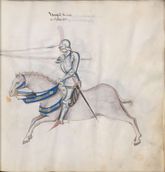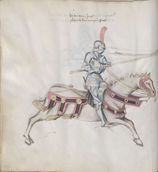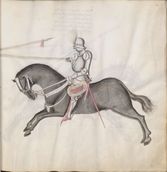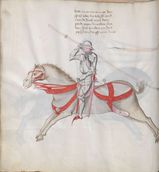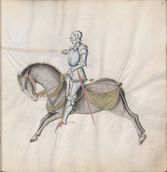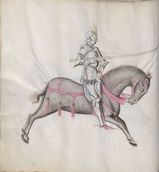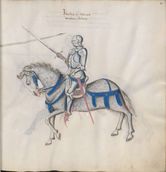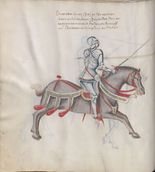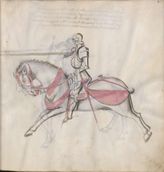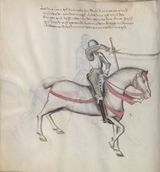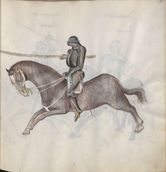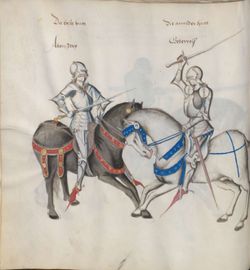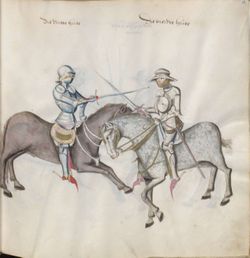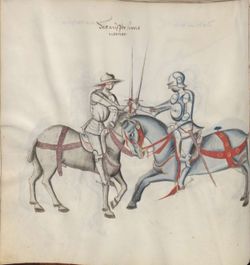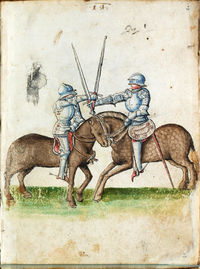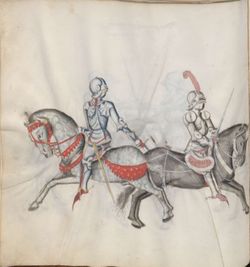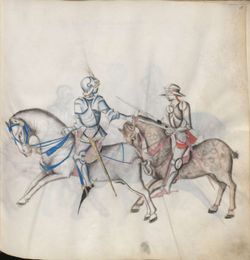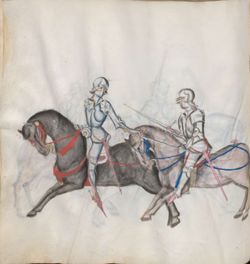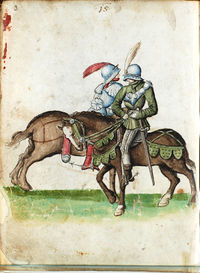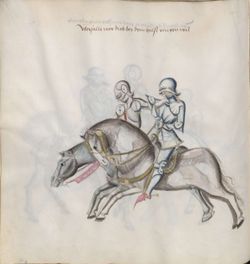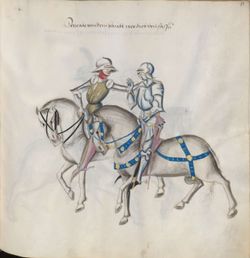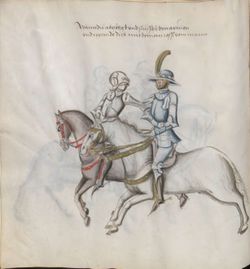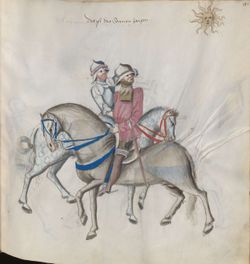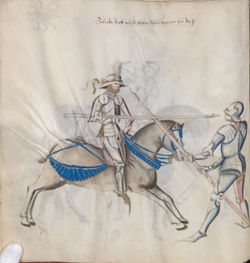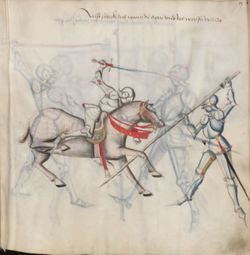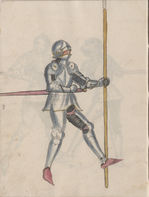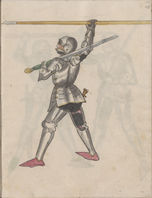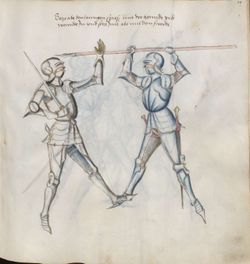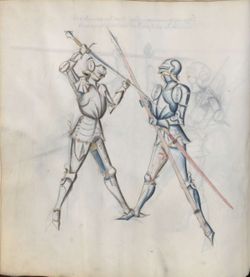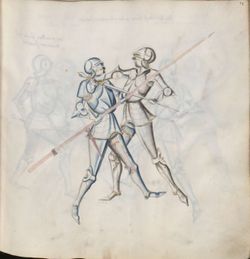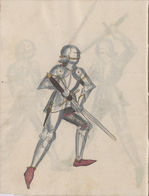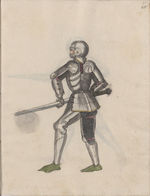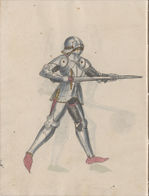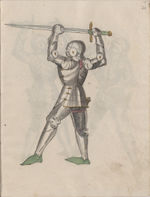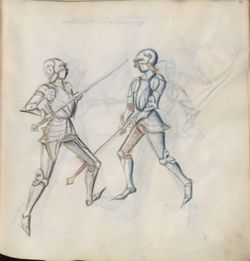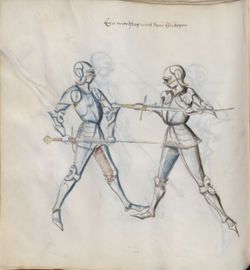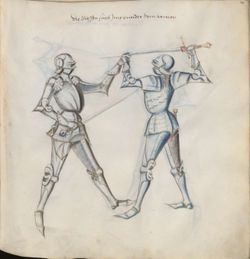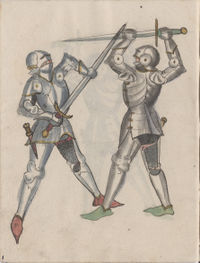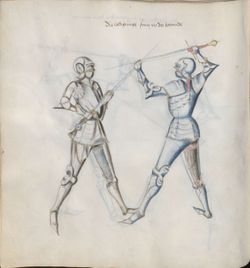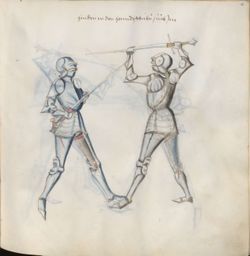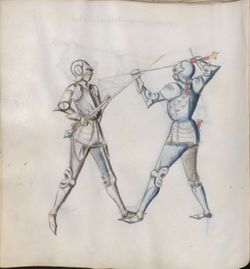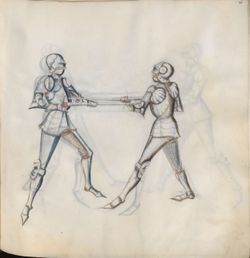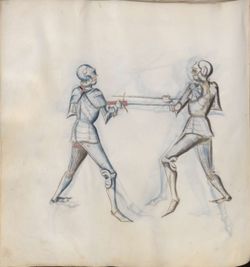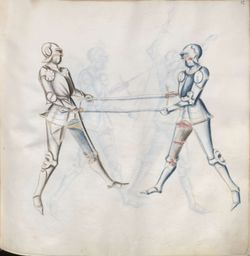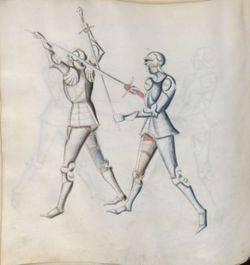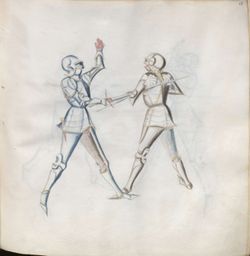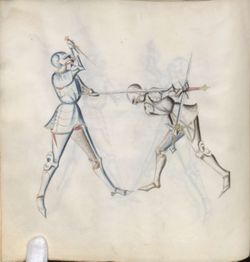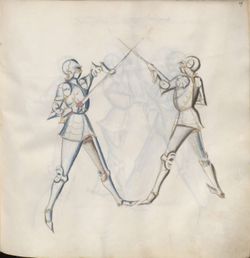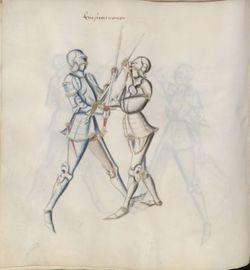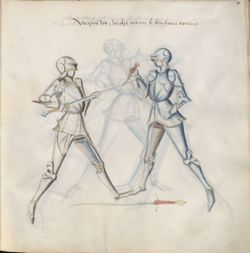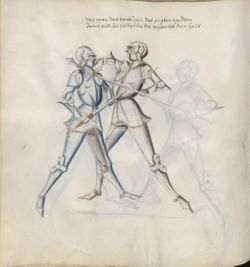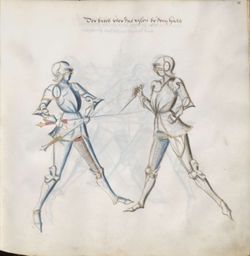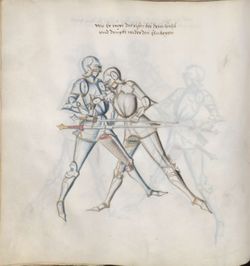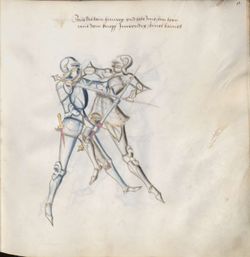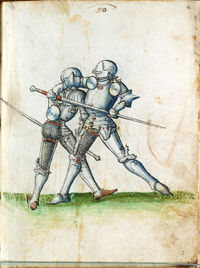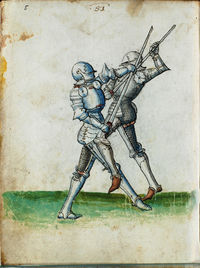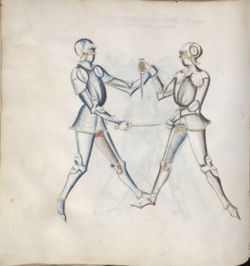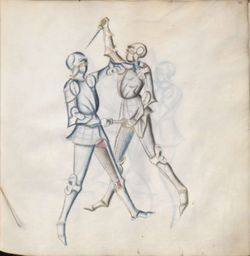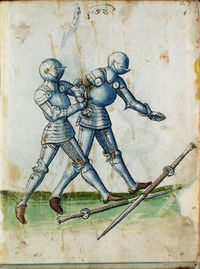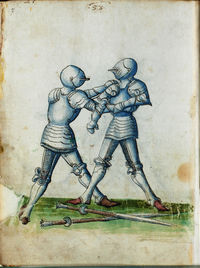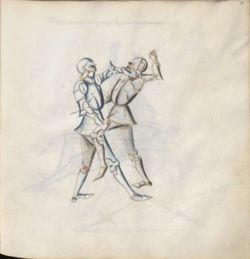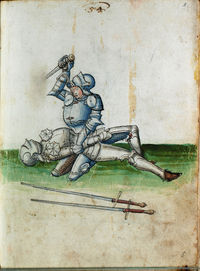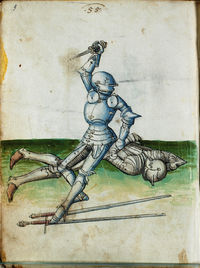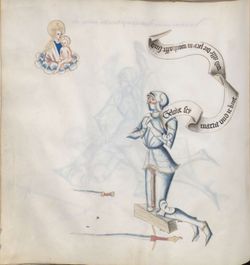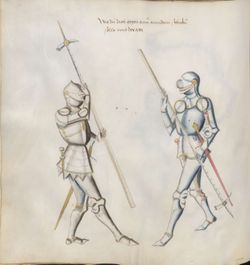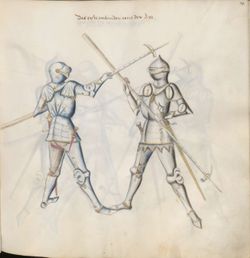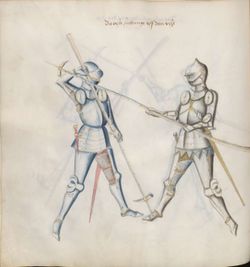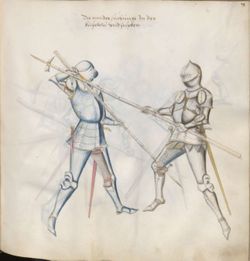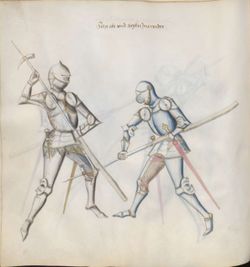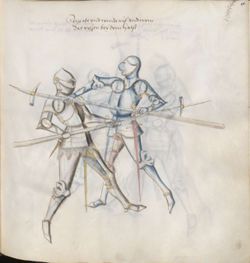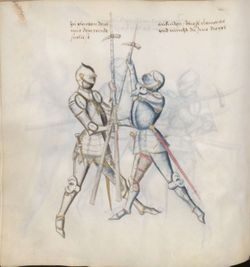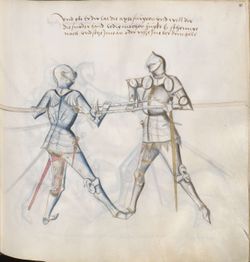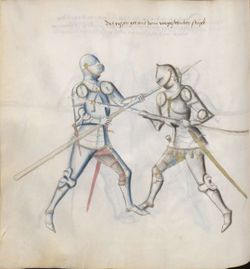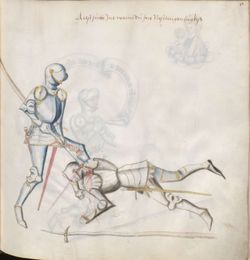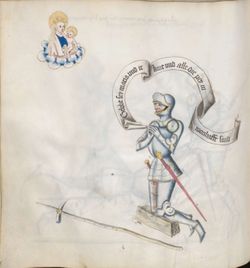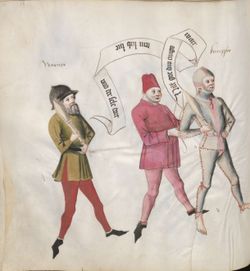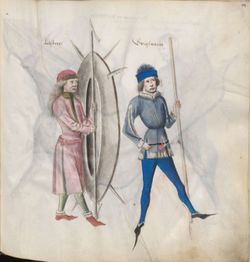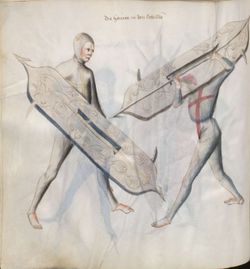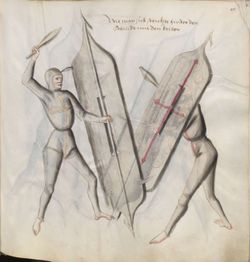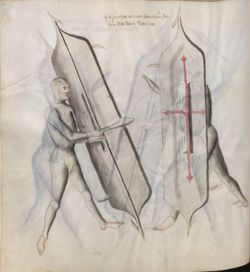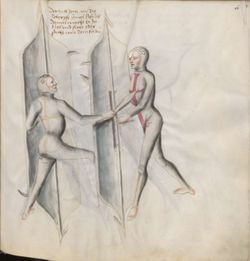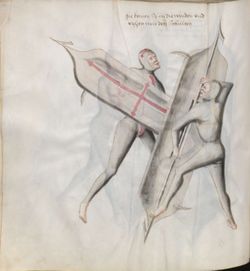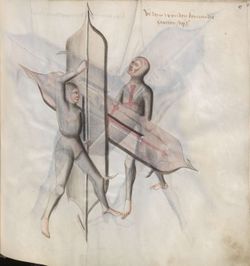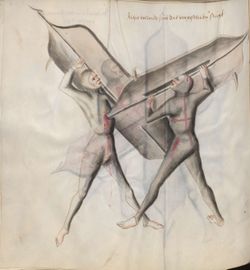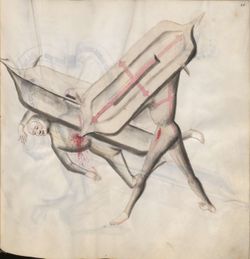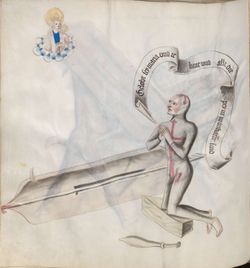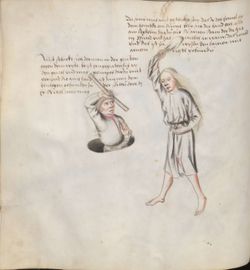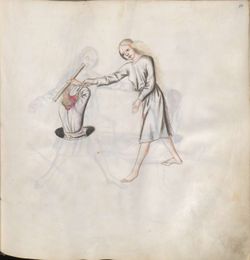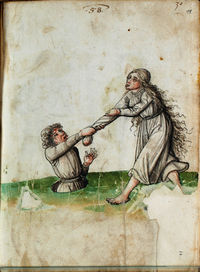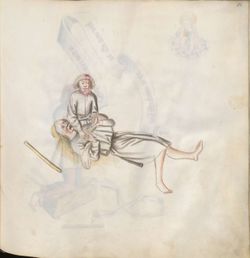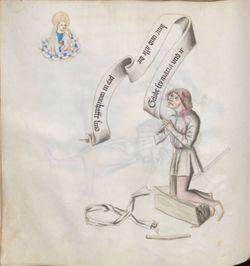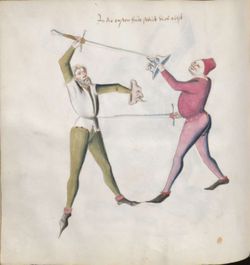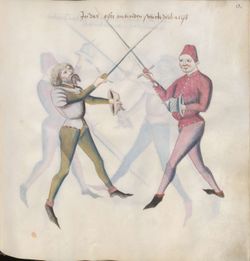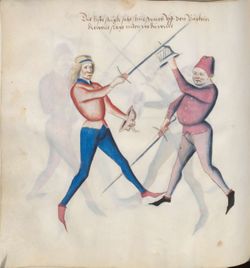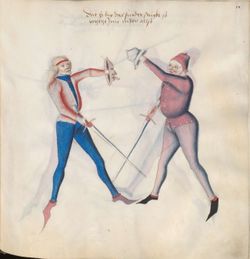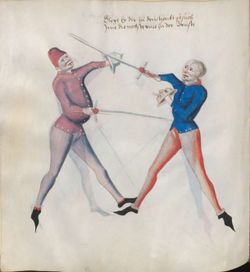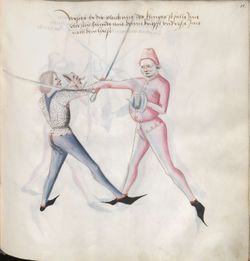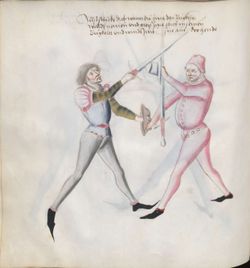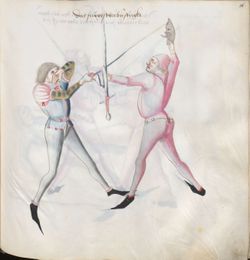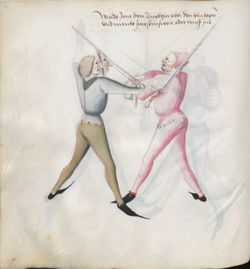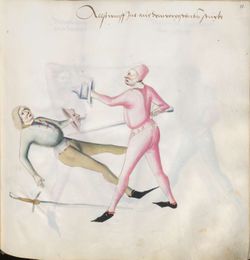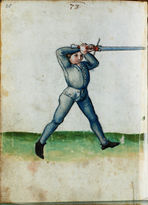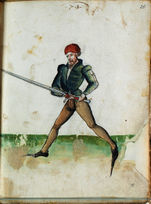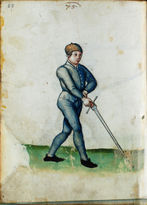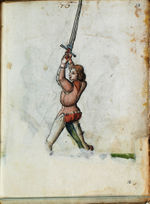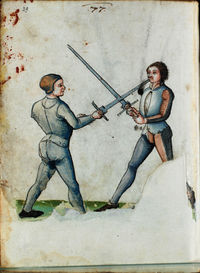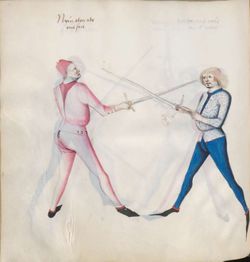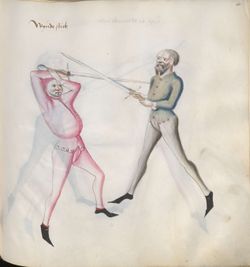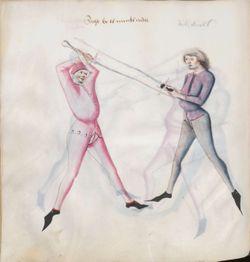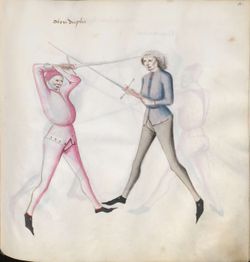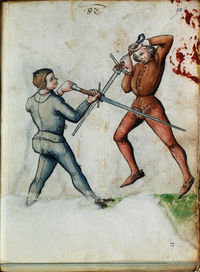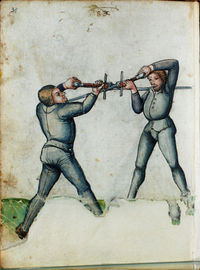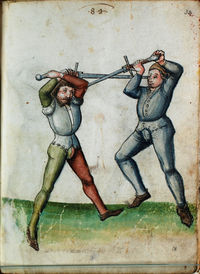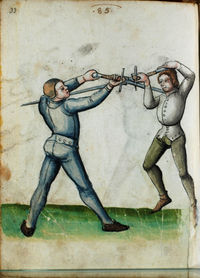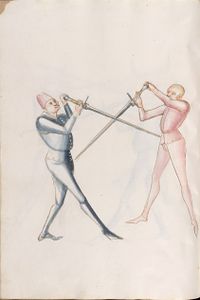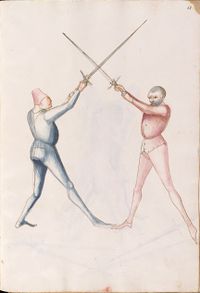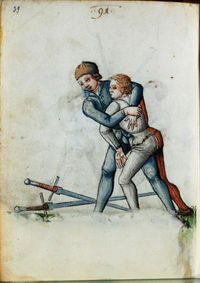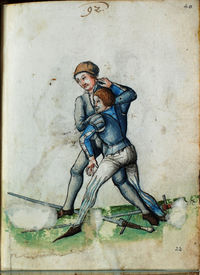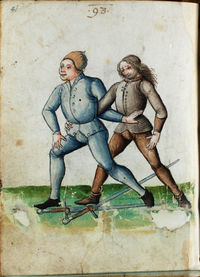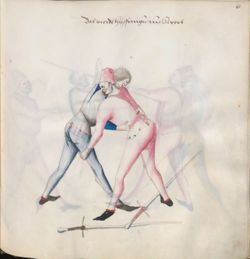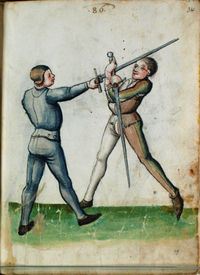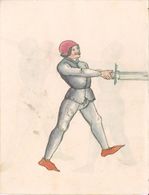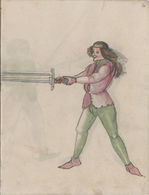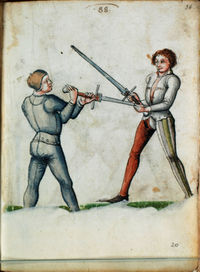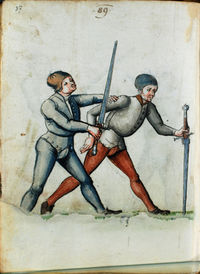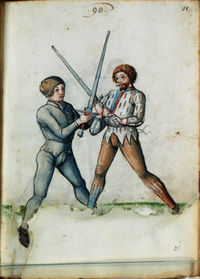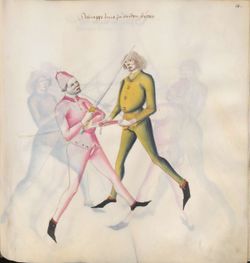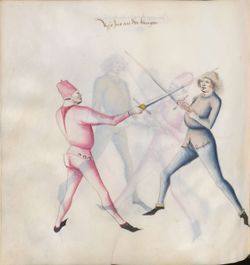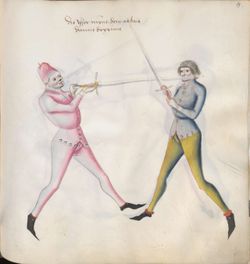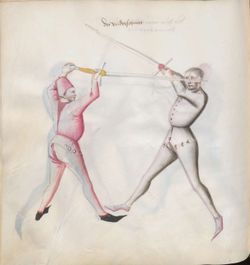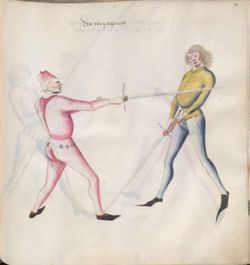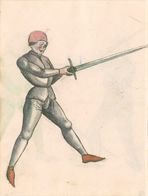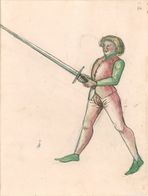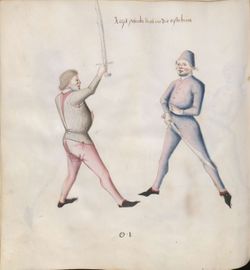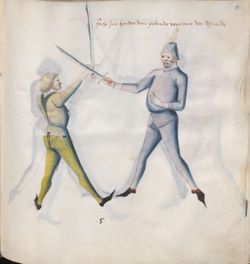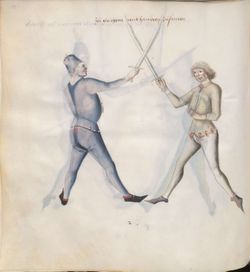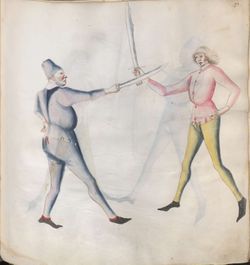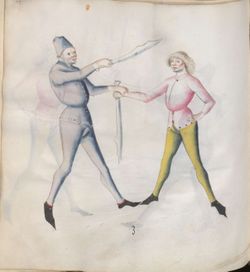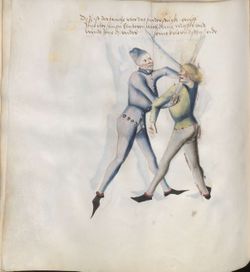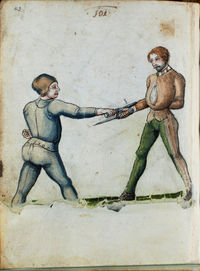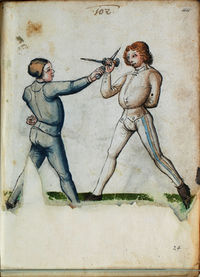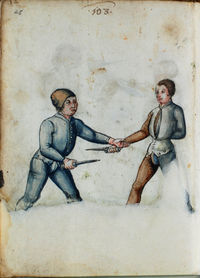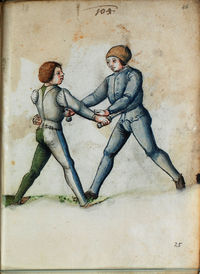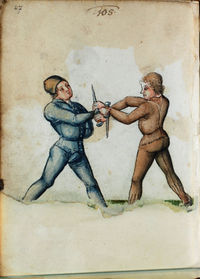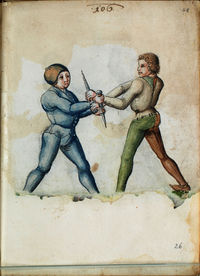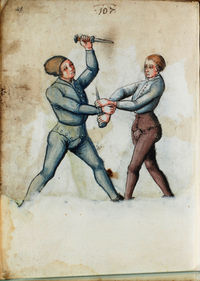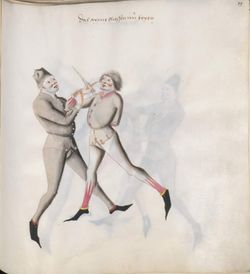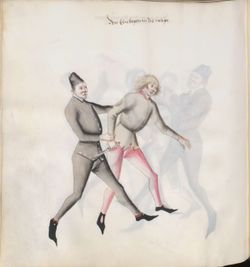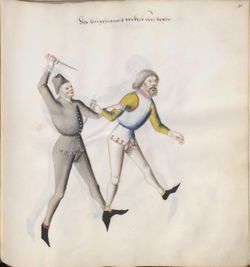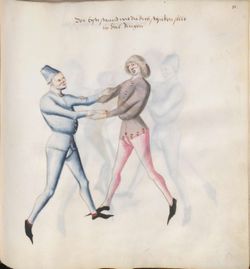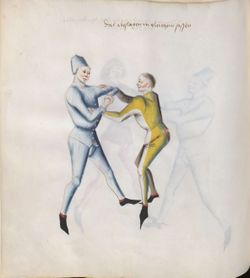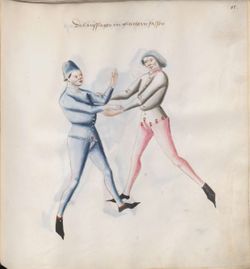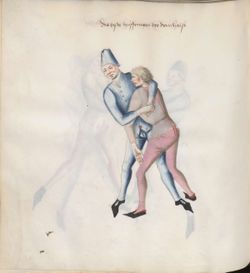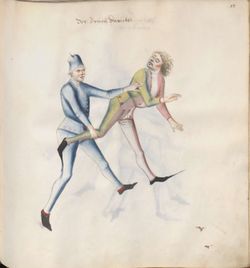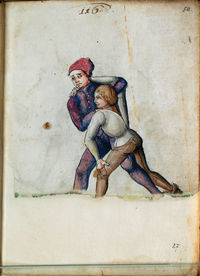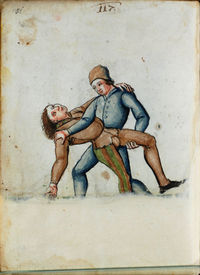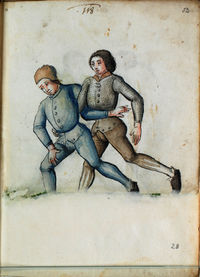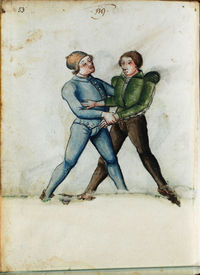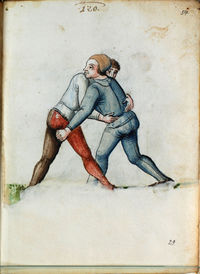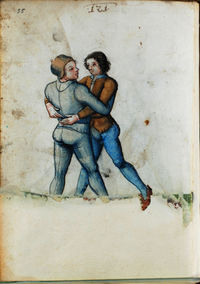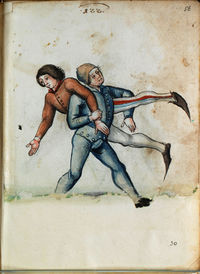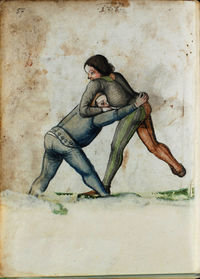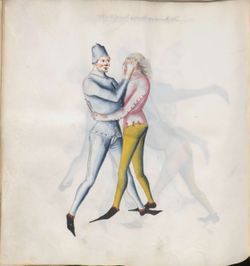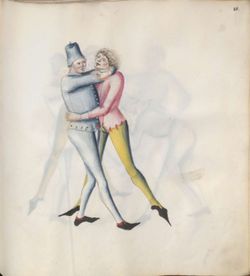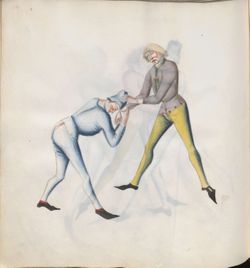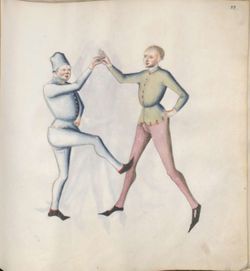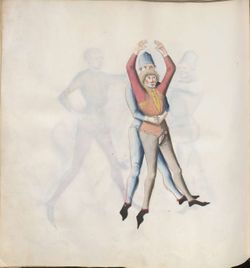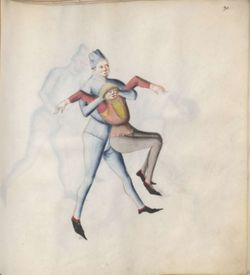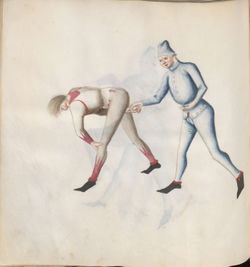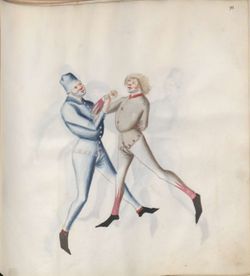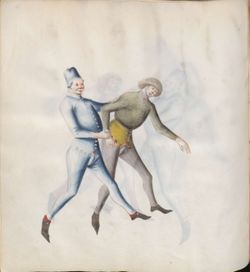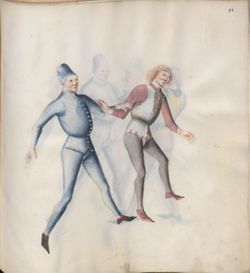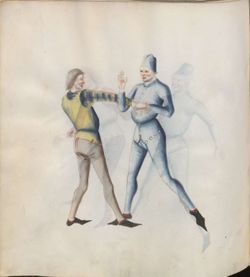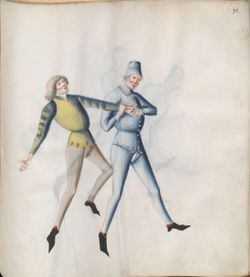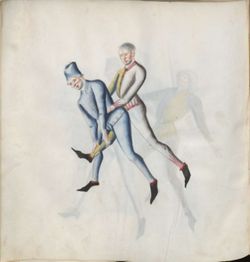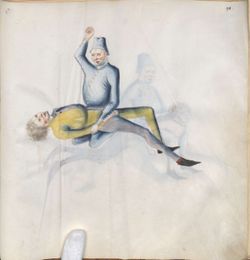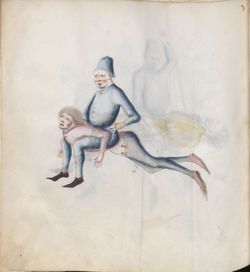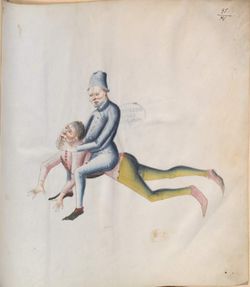|
|
You are not currently logged in. Are you accessing the unsecure (http) portal? Click here to switch to the secure portal. |
Difference between revisions of "Paulus Kal"
| Line 832: | Line 832: | ||
|- | |- | ||
| [[File:Cgm 1507 37v.jpg|250px|center]] | | [[File:Cgm 1507 37v.jpg|250px|center]] | ||
| − | | <p>The way you will confront someone with the axe.</p> | + | | <p>'''The way you will confront someone with the axe.'''</p> |
| {{paget|Page:Cgm 1507|37v|jpg}} | | {{paget|Page:Cgm 1507|37v|jpg}} | ||
| | | | ||
| Line 842: | Line 842: | ||
|- | |- | ||
| [[File:Cgm 1507 38r.jpg|250px|center]] | | [[File:Cgm 1507 38r.jpg|250px|center]] | ||
| − | | <p>The first binding-on with the axe.</p> | + | | <p>'''The first binding-on with the axe.'''</p> |
| + | |||
| + | <p>Note now when you use the pollaxe to fence, learn high and low binding-on as with the staff.<ref>It is unclear whether Paulus Kal left behind any staff treatises, but this indicates a clear connection between staff and pollaxe fighting.</ref></p> | ||
| {{paget|Page:Cgm 1507|38r|jpg}} | | {{paget|Page:Cgm 1507|38r|jpg}} | ||
| | | | ||
| {{paget|Page:MS KK5126|42r|jpg|blk=1}} | | {{paget|Page:MS KK5126|42r|jpg|blk=1}} | ||
| + | |||
| + | {{section|Page:MS KK5126 127r.jpg|2|lbl=127r}} | ||
| | | | ||
| | | | ||
| Line 852: | Line 856: | ||
|- | |- | ||
| [[File:Cgm 1507 38v.jpg|250px|center]] | | [[File:Cgm 1507 38v.jpg|250px|center]] | ||
| − | | <p>The first attempt at the wrenching.</p> | + | | <p>'''The first attempt at the wrenching.'''</p> |
| + | |||
| + | <p>Next you come to the first play. If he holds his hammer above him, then hold your thumb underneath by the left leg across the body. If he strikes from above, then parry with the lower part of the axe held above...</p> | ||
| {{paget|Page:Cgm 1507|38v|jpg}} | | {{paget|Page:Cgm 1507|38v|jpg}} | ||
| | | | ||
| {{paget|Page:MS KK5126|42v|jpg|blk=1}} | | {{paget|Page:MS KK5126|42v|jpg|blk=1}} | ||
| + | |||
| + | {{section|Page:MS KK5126 127r.jpg|3|lbl=-|p=1}} | ||
| | | | ||
| | | | ||
| Line 862: | Line 870: | ||
|- | |- | ||
| [[File:Cgm 1507 39r.jpg|250px|center]] | | [[File:Cgm 1507 39r.jpg|250px|center]] | ||
| − | | <p>Another attempt at crippling and pulling.</p> | + | | <p>'''Another attempt at crippling and pulling.'''</p> |
| + | |||
| + | <p>...Or let fly at him with a sweep and hook the axe inside the right knee to pull him down.</p> | ||
| + | |||
| + | <p>Next he wants to perform the above play on you and hook you. When he lays the hook on you, strike with your axe from inside against his axe, lay with it against his leg and pull upwards with it as mentioned.</p> | ||
| {{paget|Page:Cgm 1507|39r|jpg}} | | {{paget|Page:Cgm 1507|39r|jpg}} | ||
| | | | ||
| {{paget|Page:MS KK5126|43r|jpg|blk=1}} | | {{paget|Page:MS KK5126|43r|jpg|blk=1}} | ||
| + | |||
| + | {{section|Page:MS KK5126 127r.jpg|4|lbl=-|p=1}} | ||
| + | |||
| + | {{section|Page:MS KK5126 127r.jpg|5|lbl=-|p=1}} | ||
| {{paget|Page:MS Chart.B.1021|15v|jpg|blk=1}} | | {{paget|Page:MS Chart.B.1021|15v|jpg|blk=1}} | ||
| | | | ||
| Line 872: | Line 888: | ||
|- | |- | ||
| [[File:Cgm 1507 39v.jpg|250px|center]] | | [[File:Cgm 1507 39v.jpg|250px|center]] | ||
| − | | <p>A parry and hook in return.</p> | + | | <p>'''A parry and hook in return.'''</p> |
| + | |||
| + | <p>Next if he counters the play above, then come in with the axe and wind in upwards...</p> | ||
| {{paget|Page:Cgm 1507|39v|jpg}} | | {{paget|Page:Cgm 1507|39v|jpg}} | ||
| | | | ||
| {{paget|Page:MS KK5126|43v|jpg|blk=1}} | | {{paget|Page:MS KK5126|43v|jpg|blk=1}} | ||
| + | |||
| + | {{section|Page:MS KK5126 127r.jpg|6|lbl=-}} | ||
| | | | ||
| | | | ||
| Line 882: | Line 902: | ||
|- | |- | ||
| [[File:Cgm 1507 40r.jpg|250px|center]] | | [[File:Cgm 1507 40r.jpg|250px|center]] | ||
| − | | <p>Displace, wind up, and wrench him down by the neck.</p> | + | | <p>'''Displace, wind up, and wrench him down by the neck.'''</p> |
| + | |||
| + | <p>...Wrench at his neck from above and set him back over your left leg on the right, or over the right leg to the left, and throw him. The play works from both sides.</p> | ||
| {{paget|Page:Cgm 1507|40r|jpg}} | | {{paget|Page:Cgm 1507|40r|jpg}} | ||
| | | | ||
| {{paget|Page:MS KK5126|44r|jpg|blk=1}} | | {{paget|Page:MS KK5126|44r|jpg|blk=1}} | ||
| + | |||
| + | {{section|Page:MS KK5126 127r.jpg|7|lbl=-}} | ||
| {{paget|Page:MS Chart.B.1021|16r|jpg|blk=1}} | | {{paget|Page:MS Chart.B.1021|16r|jpg|blk=1}} | ||
| | | | ||
| Line 892: | Line 916: | ||
|- | |- | ||
| [[File:Cgm 1507 40v.jpg|250px|center]] | | [[File:Cgm 1507 40v.jpg|250px|center]] | ||
| − | | <p>Wind through quickly and directly like this; bind on and cast your point forward, pulling | + | | <p>'''Wind through quickly and directly like this; bind on and cast your point forward, pulling the axe towards you.'''<ref>This looks something like the ''reissen'' in Messer.</ref></p> |
| − | the axe towards you.<ref>This looks something like the ''reissen'' in Messer.</ref></p> | + | |
| + | <p>Next, he binds on to you and both hammers stand upright. If he makes a peasant strike at you, sense and act as if you will parry, but let his strike go through forward so you can hook him by the nape, or strike him freely to the head, the shoulder or the arm.</p> | ||
| {{paget|Page:Cgm 1507|40v|jpg}} | | {{paget|Page:Cgm 1507|40v|jpg}} | ||
| | | | ||
| {{paget|Page:MS KK5126|44v|jpg|blk=1}} | | {{paget|Page:MS KK5126|44v|jpg|blk=1}} | ||
| + | |||
| + | {{section|Page:MS KK5126 127r.jpg|8|lbl=-}} | ||
| {{paget|Page:MS Chart.B.1021|16v|jpg|blk=1}} | | {{paget|Page:MS Chart.B.1021|16v|jpg|blk=1}} | ||
| | | | ||
| Line 903: | Line 930: | ||
|- | |- | ||
| [[File:Cgm 1507 41r.jpg|250px|center]] | | [[File:Cgm 1507 41r.jpg|250px|center]] | ||
| − | | <p>And if he straightens the axe to pull your leading hand free, when he pulls, hang<ref>Hang likely means to push the shaft through with your rear hand, suspending the head of the axe in front of you.</ref> after and impale<ref>''Ansetzen''.</ref> him, or wrench him down by the neck.</p> | + | | <p>'''And if he straightens the axe to pull your leading hand free, when he pulls, hang<ref>Hang likely means to push the shaft through with your rear hand, suspending the head of the axe in front of you.</ref> after and impale<ref>''Ansetzen''.</ref> him, or wrench him down by the neck.'''</p> |
| + | |||
| + | <p>Next if he strikes at the same time as you and wants to pull your leading hand free, then give way and take his (hand) from him. If he sets his axe on to you, then set yours also onto him,<ref>Original appears to be nonsensical. With some consultation this is about as clear a translation I came across.</ref> and lengthen your axe...</p> | ||
| {{paget|Page:Cgm 1507|41r|jpg}} | | {{paget|Page:Cgm 1507|41r|jpg}} | ||
| | | | ||
| {{paget|Page:MS KK5126|45r|jpg|blk=1}} | | {{paget|Page:MS KK5126|45r|jpg|blk=1}} | ||
| + | |||
| + | {{section|Page:MS KK5126 127r.jpg|9|lbl=-}} | ||
| {{paget|Page:MS Chart.B.1021|17r|jpg|blk=1}} | | {{paget|Page:MS Chart.B.1021|17r|jpg|blk=1}} | ||
| | | | ||
| Line 913: | Line 944: | ||
|- | |- | ||
| [[File:Cgm 1507 41v.jpg|250px|center]] | | [[File:Cgm 1507 41v.jpg|250px|center]] | ||
| − | | <p>The wrenching from the previous play.</p> | + | | <p>'''The wrenching from the previous play.'''</p> |
| + | |||
| + | <p>...Then pull the left leg backward and place your axe on your right side, thus you have over-extended him.</p> | ||
| {{paget|Page:Cgm 1507|41v|jpg}} | | {{paget|Page:Cgm 1507|41v|jpg}} | ||
| | | | ||
| {{paget|Page:MS KK5126|45v|jpg|blk=1}} | | {{paget|Page:MS KK5126|45v|jpg|blk=1}} | ||
| + | |||
| + | {{section|Page:MS KK5126 127r.jpg|10|lbl=-}} | ||
| | | | ||
| | | | ||
| Line 923: | Line 958: | ||
|- | |- | ||
| [[File:Cgm 1507 42r.jpg|250px|center]] | | [[File:Cgm 1507 42r.jpg|250px|center]] | ||
| − | | <p>Seek to pierce between the armour.</p> | + | | <p>'''Seek to pierce between the armour.'''</p> |
| {{paget|Page:Cgm 1507|42r|jpg}} | | {{paget|Page:Cgm 1507|42r|jpg}} | ||
| | | | ||
| Line 933: | Line 968: | ||
|- | |- | ||
| [[File:Cgm 1507 42v.jpg|250px|center]] | | [[File:Cgm 1507 42v.jpg|250px|center]] | ||
| − | | <p>Blessed be Maria and Child, and all who are with them.</p> | + | | <p>'''Blessed be Maria and Child, and all who are with them.'''</p> |
| {{paget|Page:Cgm 1507|42v|jpg}} | | {{paget|Page:Cgm 1507|42v|jpg}} | ||
| | | | ||
| {{paget|Page:MS KK5126|46v|jpg|blk=1}} | | {{paget|Page:MS KK5126|46v|jpg|blk=1}} | ||
| + | | | ||
| + | | | ||
| + | | | ||
| + | |||
| + | |} | ||
| + | {{master end}} | ||
| + | |||
| + | {{master begin | ||
| + | | title = Advice on dueling | ||
| + | | width = 224em | ||
| + | }} | ||
| + | {| class="floated master" style="clear:both;" | ||
| + | |- | ||
| + | ! <p>Images</p> | ||
| + | ! <p>{{rating|C}}<br/>by [[Jens P. Kleinau]]</p> | ||
| + | ! <p>[[Paulus Kal Fechtbuch (Cgm 1507)|Munich Transcription]] (ca. 1470){{edit index|Paulus Kal Fechtbuch (Cgm 1507)}}<br/>by [[Dierk Hagedorn]]</p> | ||
| + | ! <p>[[Paulus Kal Fechtbuch (MS 1825)|Bologna Transcription]] (1460-1480){{edit index|Paulus Kal Fechtbuch (MS 1825)}}<br/>by [[Dierk Hagedorn]]</p> | ||
| + | ! <p>[[Paulus Kal Fechtbuch (MS KK5126)|Vienna Transcription]] (ca. 1480s){{edit index|Paulus Kal Fechtbuch (MS KK5126)}}<br/>by [[Dierk Hagedorn]]</p> | ||
| + | ! <p>[[Paulus Kal Fechtbuch (MS Chart.B.1021)|Gotha Transcription]] (ca. 1473-1503){{edit index|Paulus Kal Fechtbuch (MS Chart.B.1021)}}<br/></p> | ||
| + | ! <p>[[Solothurner Fechtbuch (Cod.S.554)|Solothurn Transcription]] (ca. 1506-1514){{edit index|Solothurner Fechtbuch (Cod.S.554)}}<br/></p> | ||
| + | ! <p>[[Paulus Kal Fechtbuch (Gotti MS)|Gotti Transcription]]{{edit index|Paulus Kal Fechtbuch (Gotti MS)}}<br/></p> | ||
| + | |||
| + | |- | ||
| + | | | ||
| + | | <p>First he should inquire before the assembly about all things and rights which a fighter should have according to the law, may it be an advisor, a listener and a grid-wardner, and what a fighter should have (possess or be equipped with). </p> | ||
| + | | | ||
| + | | | ||
| + | | {{section|Page:MS KK5126 128v.jpg|1|lbl=128v}} | ||
| + | | | ||
| + | | | ||
| + | | | ||
| + | |||
| + | |- | ||
| + | | | ||
| + | | <p>When his advisor is named, he should ask how he should advise, so that he does it lawfully and not unlawfully. </p> | ||
| + | | | ||
| + | | | ||
| + | | {{section|Page:MS KK5126 128v.jpg|2|lbl=-}} | ||
| + | | | ||
| + | | | ||
| + | | | ||
| + | |||
| + | |- | ||
| + | | | ||
| + | | <p>He should also ask if he and the advisor may go to the fighter while he is seated at his rest-place and speak to him (negotiate) about their claims.</p> | ||
| + | | | ||
| + | | | ||
| + | | {{section|Page:MS KK5126 128v.jpg|3|lbl=-}} | ||
| + | | | ||
| + | | | ||
| + | | | ||
| + | |||
| + | |- | ||
| + | | | ||
| + | | <p>He should then ask whether he won or lost victory, if he and his advisor may go to him and talk about their claims, when he his back again at his rest-place in the circle.</p> | ||
| + | | | ||
| + | | | ||
| + | | {{section|Page:MS KK5126 128v.jpg|4|lbl=-}} | ||
| + | | | ||
| + | | | ||
| + | | | ||
| + | |||
| + | |- | ||
| + | | | ||
| + | | <p>When the grid-warden or the listener is named, then he should ask how he should loose so that he does it lawfully and not unlawfully.</p> | ||
| + | | | ||
| + | | | ||
| + | | {{section|Page:MS KK5126 128v.jpg|5|lbl=-}} | ||
| + | | | ||
| + | | | ||
| + | | | ||
| + | |||
| + | |- | ||
| + | | | ||
| + | | <p>He should also ask how he should handle the staff so that he does it lawfully.</p> | ||
| + | | | ||
| + | | | ||
| + | | {{section|Page:MS KK5126 128v.jpg|6|lbl=-}} | ||
| + | | | ||
| + | | | ||
| + | | | ||
| + | |||
| + | |- | ||
| + | | | ||
| + | | <p>He should also ask, if one requires the staff, how he should push down the staff, so that he does it lawfully and not unlawfully.</p> | ||
| + | | | ||
| + | | | ||
| + | | {{section|Page:MS KK5126 128v.jpg|7|lbl=-}} | ||
| + | | | ||
| + | | | ||
| + | | | ||
| + | |||
| + | |- | ||
| + | | | ||
| + | | <p>He should also ask what the grid-warden or the listener should listen or see and how they should bring it forward, so that they do it lawfully and not unlawfully.</p> | ||
| + | | | ||
| + | | | ||
| + | | {{section|Page:MS KK5126 128v.jpg|8|lbl=-}} | ||
| + | | | ||
| + | | | ||
| + | | | ||
| + | |||
| + | |- | ||
| + | | | ||
| + | | <p>He should also ask, if that, what the grid-warden say unanimously, when they had seen or listen something, will rightfully stay that way.</p> | ||
| + | | | ||
| + | | | ||
| + | | {{section|Page:MS KK5126 128v.jpg|9|lbl=-}} | ||
| + | | | ||
| + | | | ||
| + | | | ||
| + | |||
| + | |- | ||
| + | | | ||
| + | | <p>He should also ask, if the grid-warden, are not related to each other, that they do not reject together, what the judges had seen or listened, such that it not stays rightfully, what should stay, and should be said by them too.</p> | ||
| + | | | ||
| + | | | ||
| + | | {{section|Page:MS KK5126 128v.jpg|10|lbl=-}} | ||
| + | | | ||
| + | | | ||
| + | | | ||
| + | |||
| + | |- | ||
| + | | | ||
| + | | <p>He should also ask, may it be the grid-warden or the judge, that they should say, that they process the law, that one can find [in a book].</p> | ||
| + | | | ||
| + | | | ||
| + | | {{section|Page:MS KK5126 128v.jpg|11|lbl=-}} | ||
| + | | | ||
| + | | | ||
| + | | | ||
| + | |||
| + | |- | ||
| + | | | ||
| + | | <p>He should also then ask which fighter shall be the first to strike, if he has the right to choose and to have the advantage to be the first to enter the circle to sit with his chair where he wants.</p> | ||
| + | | | ||
| + | | | ||
| + | | {{section|Page:MS KK5126 128v.jpg|12|lbl=-}} | ||
| + | | | ||
| + | | | ||
| + | | | ||
| + | |||
| + | |- | ||
| + | | | ||
| + | | <p>He should also ask how many maces he should have and what he shall have for the combat.</p> | ||
| + | | | ||
| + | | | ||
| + | | {{section|Page:MS KK5126 128v.jpg|13|lbl=-}} | ||
| + | | | ||
| + | | | ||
| + | | | ||
| + | |||
| + | |- | ||
| + | | | ||
| + | | <p>He should also ask what the regulation is, when he loses a mace outside of the circle.</p> | ||
| + | | | ||
| + | | | ||
| + | | {{section|Page:MS KK5126 128v.jpg|14|lbl=-}} | ||
| + | | | ||
| + | | | ||
| + | | | ||
| + | |||
| + | |- | ||
| + | | | ||
| + | | <p>He should ask too, if he loses a mace, which remains inside of the circle, if he will have the right to get it back, if he requires it.</p> | ||
| + | | | ||
| + | | | ||
| + | | {{section|Page:MS KK5126 128v.jpg|15|lbl=-}} | ||
| + | | | ||
| + | | | ||
| + | | | ||
| + | |||
| + | |- | ||
| + | | | ||
| + | | <p>He should ask if his grid-warden is allowed to have a mace on him or is allowed to request one, that he may bring to him, so that he does it with Right and not unlawfully.</p> | ||
| + | | | ||
| + | | | ||
| + | | {{section|Page:MS KK5126 128v.jpg|16|lbl=-}} | ||
| + | | | ||
| + | | | ||
| + | | | ||
| + | |||
| + | |- | ||
| + | | | ||
| + | | <p>He should ask what can go outside the circle, may it be a hand, a body, a foot, a shield, or a mace, what is the regulation on this.</p> | ||
| + | | | ||
| + | | | ||
| + | | {{section|Page:MS KK5126 128v.jpg|17|lbl=-}} | ||
| + | | | ||
| + | | | ||
| + | | | ||
| + | |||
| + | |- | ||
| + | | | ||
| + | | <p>He should ask how many staffs, he is allowed to request for, and after how many he would lose the victory.</p> | ||
| + | | | ||
| + | | | ||
| + | | {{section|Page:MS KK5126 128v.jpg|18|lbl=-}} | ||
| + | | | ||
| + | | | ||
| + | | | ||
| + | |||
| + | |- | ||
| + | | | ||
| + | | <p>He should ask, if they should not be rightfully proved, such that they are not of the same size or his is incorrectly.</p> | ||
| + | | | ||
| + | | | ||
| + | | {{section|Page:MS KK5126 129r.jpg|1|lbl=129r}} | ||
| + | | | ||
| + | | | ||
| + | | | ||
| + | |||
| + | |- | ||
| + | | | ||
| + | | <p>He should also ask if one should not be allowed to check the shield and other things if they are correct.</p> | ||
| + | | | ||
| + | | | ||
| + | | {{section|Page:MS KK5126 129r.jpg|2|lbl=-}} | ||
| + | | | ||
| + | | | ||
| + | | | ||
| + | |||
| + | |- | ||
| + | | | ||
| + | | <p>He should ask how often he may have his rest and how long.</p> | ||
| + | | | ||
| + | | | ||
| + | | {{section|Page:MS KK5126 129r.jpg|3|lbl=-}} | ||
| + | | | ||
| + | | | ||
| + | | | ||
| + | |||
| + | |- | ||
| + | | | ||
| + | | <p>He should ask how he should stand up in the combat.</p> | ||
| + | | | ||
| + | | | ||
| + | | {{section|Page:MS KK5126 129r.jpg|4|lbl=-}} | ||
| + | | | ||
| + | | | ||
| + | | | ||
| + | |||
| + | |- | ||
| + | | | ||
| + | | <p>He should request that the all the formerly as given law declared and approved paragraphs and articles were written in(to) the book.</p> | ||
| + | | | ||
| + | | | ||
| + | | {{section|Page:MS KK5126 129r.jpg|5|lbl=-}} | ||
| + | | | ||
| + | | | ||
| + | | | ||
| + | |||
| + | |- | ||
| + | | | ||
| + | | <p>He should ask, if someone steps back from the fight, how he will be judged and by whom.</p> | ||
| + | | | ||
| + | | | ||
| + | | {{section|Page:MS KK5126 129r.jpg|6|lbl=-}} | ||
| + | | | ||
| + | | | ||
| + | | | ||
| + | |||
| + | |- | ||
| + | | | ||
| + | | <p>He should ask, if someone disturbs or makes noise, by words or any other means, what the law says on this, and if it is not rightfully forbidden, and how it is forbidden.</p> | ||
| + | | | ||
| + | | | ||
| + | | {{section|Page:MS KK5126 129r.jpg|7|lbl=-}} | ||
| + | | | ||
| + | | | ||
| + | | | ||
| + | |||
| + | |- | ||
| + | | | ||
| + | | <p>If a crowd gathers behind the circle, what are the precautions, that this will not bring any problems to the fighter.</p> | ||
| + | | | ||
| + | | | ||
| + | | {{section|Page:MS KK5126 129r.jpg|8|lbl=-}} | ||
| | | | ||
| | | | ||
Revision as of 21:54, 1 May 2017
| Paulus Kal | |
|---|---|
 | |
| Born | ca.1420s Dingolfing, Germany |
| Died | after 1485 |
| Occupation |
|
| Patron |
|
| Movement | Fellowship of Liechtenauer |
| Influences | |
| Influenced | Peter Falkner (?) |
| Genres | |
| Language | Early New High German |
| Archetype(s) | |
| Manuscript(s) |
Gotti MS (late 1400s)
|
| First printed english edition |
Tobler, 2006 |
| Concordance by | Michael Chidester, Carsten Lorbeer, Julia Lorbeer, Andreas Meier, Marita Wiedner |
| Translations | |
Paulus Kal was a 15th century German fencing master. He wrote that he studied martial arts under Hans Stettner von Mörnsheim, and was an initiate of the tradition of Johannes Liechtenauer. He was also attached as Schirrmeister to three different courts in his career, serving in various military capacities including commanding men in at least three campaigns.[1] Perhaps his most significant legacy is an honor role of masters which he styled the Fellowship of Liechtenauer (Geselschaft Liechtenauers). While many of these masters remain unknown, the several wrote treatises of their own and Kal's list stands as an independent confirmation of their connection to the grand master. Kal's treatise is also of interest in that it represents the oldest attempt to illustrate portions of Liechtenauer's Recital (Zettel).
Little is known of Kal's early life, but from 1440 to ca. 1449 he served Ludwig IV "the Gentle" of Wittelsbach, Count Palatine of the Rhine. In 1448, while in the Elector's service he participated in the defense Nuremberg, commanding a unit of wheel cannons below the gates.[2] The Nuremberg Council notes from 17 March 1449 mention that he had broken the peace of the city at that time by drawing his weapons.[2]
Kal entered the service of Ludwig IX "the Rich" of Wittelsbach, Duke of Bavaria-Landshut, on 29 September 1450.[1] In 1461, he is mentioned commanding a unit of 12 marksmen.[2] From 1465 to 1475, he seems to have also maintained a secondary occupation as a toll collector in Dingolfing.[2] In November 1468, he participated in military actions on the castle Saldenburg, which was successfully taken on 4 December.[2] Kal is listed as a guest at the wedding of Ludwig's son Georg,[2] and continued in the duke's service until his death on 18 January 1479. Paulus Kal created two manuscripts of his treatise while in the service of Ludwig IX, an uncaptioned version as well as a more elaborate presentation copy including brief explanations in German for most devices (including fragments of Liechtenauer's Recital).
On 12 February 1480, Paulus Kal entered the service of Sigismund of the House of Hapsburg, Archduke of Austria and Tyrol.[1] Kal acted as one of the archduke's witnesses at a number of interrogations held on 17 October 1485 in Innsbruck, related to the witch trials being conducted by Heinrich Kramer at that time.[2] This is the final time that Kal's name has been located in historical records. Several copies of Kal's treatise were created during the 1480s and 90s, but the only one which shows any probability of Kal's personal involvement is the extensive MS KK5126.
Contents
Treatise
In total, Paulus Kal's teachings are preserved in at least six manuscripts written between 1460 and 1514. Aside from the three already mentioned, two other extensive, text-less copies also exist (the Gotha version, copied from the Bologna, and the Solothurn version, copied from an unknown source). A sixth version was sold at auction in Italy during the 20th century as individual leaves; this copy contains unintelligible single-word captions[3] and was likely based on either the Bologna or Vienna. All six are listed in the concordance below, though only the Munich accompanies its illustrations with text. This concordance also includes the poleaxe and longshield text from the Vienna version, which largely matched the illustrations (though it's unknown whether it was intended for that purpose).
Paulus Hector Mair included content based on Kal's work in several sections of the Munich and Vienna versions of his Opus Amplissimum de Arte Athletica. Rather than using Kal's descriptions (if the copy he used had them), Mair wrote his own extensive commentary on the illustrations. The precise set of images Mair drew upon do not appear in any of the six extant manuscripts, which may signify that he used a seventh copy of Kal's work which has since been lost. Because Mair's version represents substantial original work, it is listed on his page rather than being incorporated into the concordance here.
Draft Translation |
Munich Transcription (ca. 1470) |
Bologna Transcription (1460-1480) |
Vienna Transcription (ca. 1480s) |
Gotha Transcription (ca. 1473-1503) |
Solothurn Transcription (ca. 1506-1514) |
||
|---|---|---|---|---|---|---|---|
With the help of God and of the highborn lord Duke Ludwig, Count Palatine of the Rhine, Duke of Lower and Upper Bavaria, I, Master Paulus Kal, an exponent of art, have made this book, which deals with all knightly weapons in brief succession. |
[02r] Mit hilf gottes und des hochgeporn hern herczog ludwigs pfalczgrawe peÿ rein herczog in nydern und obern bayren. Hab ich maister pauls kal ain merer der kunst das püech geordenirt in aller Ritterlicher wer auf das kurczt und auf das nachst. |
[02r] Mit hilf gottes Vnd des hoch gepornen herrn hertzog lud wigs pfaltzgrauen Bey Rein herzogen In Nidern vnd obern Bayern etc hab ich maister pauls kal ain merer der kunst das puech georniert In aller Ritterlicher wëer auf das kürtzt vnd auf das nagst |
[09r] Mit hylf gotes vnnd des hochgepornnenn hern herczog ludwigs pfalczgraffne bey rein herczog in nydern vnnd obernn bayrne hab ich maister pauls kal ain merer der chunst das puech geornyrt in aller ritterlicher wer auf das churczt vnd auf das nachst |
||||
Here begins the art that Liechtenauer has created with his fellowship and applied with all knightly weapons. May God have mercy on him. |
Hye hebt sich an die kunst die liechtenawer mit seiner geselschafft gemacht und gepraücht hat in aller ritterliche wer das im got genädig seÿ. |
[02v] Hye hebt sich an dye kunst dye liechtenawer mit siner geselschaft gemacht vnd gepraucht hat, In aller [Ri]tterlichen weer das Im got genedig sey |
Hie hebt sich an die chunnst die liechtnawer mit seiner geselschafft gemacht vnnd gepraucht hat in aller Ritterlichenn wer das im got genädig sey |
||||
Master Johannes Liechtenauer. |
Maister hanns liechtenawer. |
Maister hanns liechtenawer |
Maister hanns liechtnauer |
||||
The noble and zealous Hans Stettner von Mörnsheim, which is most of all the master of all pupils—and I, Master Paulus Kal, was his student—may God have mercy on him above all of them. |
Der edel vnd fest stettner der am maisten der maister aller schüller gewessen ist vnd ich maister pauls kal pin sein schuler gewessen dat im got genädig seÿ vor in allen. |
Der Edel vnd [fe]st Stettner der am maisten der maister aller Schüeler gewesen ist Vnd ich Maister pauls kall pin sein Schüeler gewesen das Im got genedig sey vor In allen |
Der edl vnd vest der stetner der am maisten der maister aller schueller gewessenn yst und ich mayster pauls kal pm sein schueller gewessenn das im got genädig sey vor in allenn. |
||||
God, thou Eternal Word, help the body here, the soul there. |
[05v] hilf got du ewig wort dem leib hie der Sele dort |
[01v] [No text] |
|||||
My Lord, I vow to serve you. My God and his dear mother to be our help. |
[04r] Genediger herr ich gelob euch den dienst mein gott und sein lieb ein muter sullen unser helfer sein |
||||||
Take the sword, my lord, you will be protected by the Mother of God and the chivalrous knight, St. George. |
[05r] Nemt hin genediger herr das schwert ir wert von der muter gots und riter sand iorgen aller riterschafft gewert |
||||||
I have eyes like a hawk, so you do not deceive me.
|
[06r] Ich hab augen als ein falk das man mich nit beschalk
|
[06r] ich hab augen als ein valk · das man mich nit beschalk ·
|
[10r] [No text] |
[02r] [No text] |
Draft Translation |
Munich Transcription (ca. 1470) |
Bologna Transcription (1460-1480) |
Vienna Transcription (ca. 1480s) |
Gotha Transcription (ca. 1473-1503) |
Solothurn Transcription (ca. 1506-1514) |
||||
|---|---|---|---|---|---|---|---|---|---|
Your spear extends very far.
|
[06v] Sine spere beriecht nach dem lengsten [07r] Wechsel dúrch vnd setze an. |
[06v] [No text] [07r] [No text] |
[10v] [No text] [11r] [No text] |
[03v] [No text] [04r] [No text] |
[001] [No text] |
||||
At the half spear, set aside the long spear. |
[07v] Zú halbem spies setze abe den langen spies [08r] PANI THETRA GRAMATHON |
[07v] [No text] [08r] [No text] |
[11v] [No text] [12r] [No text] |
[04v] [No text] [05r] [No text] |
|||||
Raise your spear over the shoulder and turn the horse to him, or set the spear behind the buttocks and meet him. |
[08v] Hebe in ainer ennge den spiesz vber die achssel vnd wendt dich mit dem pferde gegen Jme oder setze den spies hinden an das gesesse vnd triff mit Jme [09r] [No text] |
[08v] [No text] |
[12v] [No text] [13r] [No text] |
[05v] [No text] [06r] [No text] |
|||||
Set aside on your right. |
[09v] [No text] [10r] Abesetze zú deiner rechten seytten |
[13v] [No text] [14r] [No text] |
|||||||
Strike on his spear to the right side and catch his lance under your right arm. Put your pommel at the beginning of his saddle with the point. |
[10v] Slage über seinen spiesz zú der rechten sytten vnd fahe seinen spies vnder deinen rechten armen vnd setze deinen knaůff ann Satlbogen vnd fahe Jne an das ort [11r] [No text] |
[14v] [No text] [15r] [No text] |
|||||||
Put your sword on the left hand on your bridle, and as far away from you as you can. Setting it aside with the blade and plunge with the hilt his spear to the ground. Turn your pommel to the saddle bow, and set upon him with the point where you can. |
[11v] Lege dine swert úff die lingken handt zú dime zaúme vnd allsuene dú von dir magst so setze Jme abe mit der klingen vnd stosse nider mit dem gehultze Jme seinen spiesse aúf die erde vnd verwendt dich mit dem knopfe an deinen Satlbogen vnd setze Jme mit dein ort an wo dú magst [12r] [No text] |
[15v] [No text] [16r] [No text] |
[06v] [No text] [07r] [No text] |
||||||
The first guard.
|
[16v] [No text] |
[07v] [No text] |
|||||||
The third guard.
|
[13r] Die dritte húte
|
[17r] [No text] |
[08r] [No text] |
||||||
The outer sword taking. |
[13v] Das ausser swert nemen |
[17v] [No text] |
[08v] [No text] |
||||||
The inner sword taking. |
[14r] Das Jnner swert nemen |
[18r] [No text] |
[09r] [No text] |
[14] [No text] |
|||||
[14v] [No text] |
[18v] [No text] |
||||||||
[15r] [No text] |
[19r] [No text] |
||||||||
[15v] [No text] |
[19v] [No text] |
||||||||
The sheep grip fights what's under the face. |
[16r] Der Schaff griff wéret was vnnder aúgen kombt |
[20r] [No text] |
[09v] [No text] |
[015] [No text] |
|||||
Fall over whoever wants those who wrestle with you on the neck. |
[16v] Vberfalle wér dich beý dem halse ringen wil |
[20v] [No text] |
[10r] [No text] |
||||||
Set aside from the front of the head whoever will grab you. |
[17r] Setze abe von dem haübt wer dich wil fassen |
[21r] [No text] |
[10v] [No text] |
||||||
If you set aside and lock the arm, turn around with your horse away from the man. |
[17v] Wann dú abesetzest vnd slússest den armen vnd wennde dich mit deinem rosß vom mann |
[21v] [No text] |
[11r] [No text] |
||||||
This is the sun pointer. |
[18r] Das ist das Sonnen zaigen |
[22r] [No text] |
[11v] [No text] |
||||||
Embark so against the man on horseback. |
[18v] Schicke dich allso gegen dem mann zu Rosß |
[22v] [No text] |
[13r] [No text] |
||||||
Embark so to throw a man on horseback. |
[19r] Allso schicke dich wann dú man vnd Ros werffen willdt |
[23r] [No text] |
Draft Translation |
Munich Transcription (ca. 1470) |
Bologna Transcription (1460-1480) |
Vienna Transcription (ca. 1480s) |
Gotha Transcription (ca. 1473-1503) |
Solothurn Transcription (ca. 1506-1514) |
||||
|---|---|---|---|---|---|---|---|---|---|
Embark so to set aside a throw. |
[19v] Allso schicke dich abezúsetzen wider schiessen |
[23v] [No text] |
[17v] [No text] [18r] [No text] |
||||||
Setting aside the long spear with his hand and rotating it and setting it aside with the sword. |
[20r] Setze abe den lanngen spiesz mit der hennde vnd wennde Jn vnd setze Jme abe mit dem swerde. |
[24r] [No text] |
[18v] [No text] |
||||||
[20v] [No text] |
[09r] [No text] |
[24v] [No text] |
[19r] [No text] |
||||||
[21r] [No text] |
[09v] [No text] |
[25r] [No text] |
|||||||
The bottom guard in the short sword.
|
[21v] die vnnderst húte in dem kúrtzen swerde
|
[25v] [No text] |
[19v] [No text] [20r] [No text] |
||||||
The third guard under the arm.
|
[22r] die dritt húte vnnder dem vchsen
|
[26r] [No text] |
[20v] [No text] [21r] [No text] |
||||||
[22v] [No text] |
[26v] [No text] |
||||||||
[23r] [No text] |
[27r] [No text] |
[24v] [No text] |
|||||||
A murder strike to the elbow. |
[23v] Ein mordslag nach dem Elnbogen |
[10r] [No text] |
[27v] [No text] |
[24r] [No text] |
|||||
Seek his openings under the arms. |
[24r] die Blossen súch Jme vnnder dem armen |
[10v] [No text] |
[28r] [No text] |
[23v] [No text] |
|||||
[21v] [No text] |
|||||||||
The free driving in the hand. |
[24v] die ledigúnge furn in der hennde |
[11r] [No text] |
[28v] [No text] |
[22r] [No text] |
|||||
It reached behind the gauntlet. |
[25r] hinden in den henndtschúhen súch Jne |
[11v] [No text] |
[29r] [No text] |
[22v] [No text] |
|||||
[25v] [No text] |
[12r] [No text] |
[29v] [No text] |
[23r] [No text] |
||||||
[26r] [No text] |
[12v] [No text] |
[30r] [No text] |
|||||||
[26v] [No text] |
[30v] [No text] |
||||||||
[27r] [No text] |
[31r] [No text] |
||||||||
[27v] [No text] |
[13r] [No text] |
[31v] [No text] |
|||||||
[28r] [No text] |
[13v] [No text] |
[32r] [No text] |
|||||||
[28v] [No text] |
[14r] [No text] |
[32v] [No text] |
|||||||
[29r] [No text] |
[14v] [No text] |
[33r] [No text] |
|||||||
A sword taking. |
[29v] Ein swert nemen |
[33v] [No text] |
[25r] [No text] |
||||||
How he does if he loses his sword. |
[30r] Wie sich der schickt wann Er sein swert verlúrt |
[34r] [No text] |
[25v] [No text] |
||||||
How to break him by jerking the leg and tearing of the neck. |
[30v] wie man das brechen soll, das zúgken an dem Baine vnd soll fallen in die riszen beý dem hals |
[34v] [No text] |
[26r] [No text] |
||||||
The break to the tearing at the neck. |
[31r] Der bröch vber das riszen bý dem halse |
[35r] [No text] |
[26v] [No text] |
||||||
How to ward off the tearing at the neck by pushing against the elbow. |
[31v] wie Er wert das risen beý dem halse vnd drúgkt wider den Elnbogen |
[35v] [No text] |
|||||||
Put the leg to the side and raise him up with the knob inside his leg. |
[32r] Stile das bain hinweg. vnd hebe Jme sein beyn mit dem knopf Jnwendig seines baines |
[36r] [No text] |
[27r] [No text] |
||||||
Defeat a beaten man with power. |
[32v] Einen verlorn man zú krefften zúbringen |
[36v] [No text] |
[27v] [No text] |
[050] [No text] |
|||||
Pass under his eyes near the knee, bend and tear with the pommel. |
[33r] Tritte nahe vnder augen zú den knie bogen vnd risze mit dein knopfe |
[37r] [No text] |
[28r] [No text] |
[051] [No text] |
|||||
[33v] [No text] |
[37v] [No text] |
||||||||
[34r] [No text] |
[38r] [No text] |
||||||||
[34v] [No text] |
[38v] [No text] |
[052] [No text] |
|||||||
[053] [No text] |
|||||||||
[35r] [No text] |
[39r] [No text] |
||||||||
How to keep someone on his back on the ground. |
[35v] wie man ainen rugkling aúf der erden hallten soll |
[39v] [No text] |
[054] [No text] |
||||||
How to hold someone on his nose on the ground. |
[36r] Wie man ainen Neseling aúf der erden hallte soll |
[40r] [No text] |
[28v] [No text] |
[055] [No text] |
|||||
Praised be Mary and her child and all who live with them. |
[36v] Gelobt sey maria vnd ir kint vnd alle die pe: in wonhafft sind |
[40v] [No text] |
[29r] [No text] |
Munich Transcription (ca. 1470) |
Bologna Transcription (1460-1480) |
Vienna Transcription (ca. 1480s) |
Gotha Transcription (ca. 1473-1503) |
Solothurn Transcription (ca. 1506-1514) |
|||
|---|---|---|---|---|---|---|---|
The way you will confront someone with the axe. |
[37v] Wie dú dich gegen aime anndern schicken sollt mit der axe |
[41v] [No text] |
[14v] [No text] |
||||
The first binding-on with the axe. Note now when you use the pollaxe to fence, learn high and low binding-on as with the staff.[4] |
[38r] Das erste anbinden mit der Axe |
[42r] [No text] [127r] Item also schik dich mit der streyt agkst zu vechten Lern obenn vnd vndenn anpindenn als mit der stanngenn |
|||||
The first attempt at the wrenching. Next you come to the first play. If he holds his hammer above him, then hold your thumb underneath by the left leg across the body. If he strikes from above, then parry with the lower part of the axe held above... |
[38v] Die erste suchúnge vff dem risze |
[42v] [No text] Item in das erst stuck schick dich also helt er denn hamer vbersich so halt dw denn deinen vnter sich bey deinem tennckenn pain twerchs ann den leyb slecht er vonn dach so versecz mit dem vndern tail der agst oben |
|||||
Another attempt at crippling and pulling. ...Or let fly at him with a sweep and hook the axe inside the right knee to pull him down. Next he wants to perform the above play on you and hook you. When he lays the hook on you, strike with your axe from inside against his axe, lay with it against his leg and pull upwards with it as mentioned. |
[39r] Die annder súchúnge. Jn der knýebelen und zúgken |
[43r] [No text] oder laß fur gen den Straich vnnd hennckel In mit der agst in der rechtenn chnypüg vnnd zuck in nyder Item wil er dir das ober stuck thun vnd wil dich henngeln legt er dir denn hackenn an so slach mit deiner achst inen an sein achst vnnd leg inen wider ann sein pain vnd ruck als obenn geschribenn stet |
[15v] [No text] |
||||
A parry and hook in return. Next if he counters the play above, then come in with the axe and wind in upwards... |
[39v] Setze abe vnd hegkel Jne wider |
[43v] [No text] Item ob er das obgeschribenn stuck pricht so secz im an mit der agst vnd wind im auf |
|||||
Displace, wind up, and wrench him down by the neck. ...Wrench at his neck from above and set him back over your left leg on the right, or over the right leg to the left, and throw him. The play works from both sides. |
[40r] Setze abe vnd winde aúf vnd nym das ryszen beý dem hals |
[44r] [No text] vnd nym das ober reyssenn bey dem hals vnd secz im das tennck pain hinder an das recht oder das recht pain das gelinck vnd wurff in vber // das stuck get zw baidenn seytenn |
[16r] [No text] |
||||
Wind through quickly and directly like this; bind on and cast your point forward, pulling the axe towards you.[5] Next, he binds on to you and both hammers stand upright. If he makes a peasant strike at you, sense and act as if you will parry, but let his strike go through forward so you can hook him by the nape, or strike him freely to the head, the shoulder or the arm. |
[40v] zú gleichem dorch anbinden schiesse lainen[!] ort mit dem winde vnd nimbst dú Jme die axt suelle so |
[44v] [No text] Item pint er dir ann das paid hamer obenn stennd vnd slecht peẅrleins so enpfind vnd thue als wild dw verseczenn vnd lass sein chlag [!] fur genn so hastu das hennckeln pey dem nackenn oder frey sleg zw dem chopf zw der achsel zw dem arm |
[16v] [No text] |
||||
And if he straightens the axe to pull your leading hand free, when he pulls, hang[6] after and impale[7] him, or wrench him down by the neck. Next if he strikes at the same time as you and wants to pull your leading hand free, then give way and take his (hand) from him. If he sets his axe on to you, then set yours also onto him,[8] and lengthen your axe... |
[41r] Vnd obe Er dir lat[!] die axte fúrgeen vnd will dir die fúrder hand ledig machen. zúgkt Er so hennge nach vnd setze Jme an oder rýsze Jne bey dem hals |
[45r] [No text] Item slecht er mit ein zw gleich ein slag vnd wil dir dy Voder hant ledigmachenn so gib nach vnd nym im die sein als er dir mit der agkst secz er dir dar inen an wie er dir anseczt also secz im auch ann vnd lenng dein agkst |
[17r] [No text] |
||||
The wrenching from the previous play. ...Then pull the left leg backward and place your axe on your right side, thus you have over-extended him. |
[41v] Das rýszen get aús dem vorgeschriben stúgk |
[45v] [No text] also zuck das tennck pain hindersich vnd secz dein agkst an dein rechte seytenn so hast dw in vberlenngt |
|||||
Seek to pierce between the armour. |
[42r] Allso súche Jne wann dů Jne Neselingen zůgkest |
[46r] [No text] |
|||||
Blessed be Maria and Child, and all who are with them. |
[42v] Gelobt seý Maria vnd ir kint vnd alle die peý in wonhafft sind |
[46v] [No text] |
Images |
Munich Transcription (ca. 1470) |
Bologna Transcription (1460-1480) |
Vienna Transcription (ca. 1480s) |
Gotha Transcription (ca. 1473-1503) |
Solothurn Transcription (ca. 1506-1514) |
||
|---|---|---|---|---|---|---|---|
First he should inquire before the assembly about all things and rights which a fighter should have according to the law, may it be an advisor, a listener and a grid-wardner, and what a fighter should have (possess or be equipped with). |
[128v] Tout [?] zw dem erstn sol im sein fursprech wandel dingenn vnd alle recht die ein chempfer von rechcz wegenn habenn sol es sey warner lüsner grieswartl vnd was ein chempfer habenn sol |
||||||
When his advisor is named, he should ask how he should advise, so that he does it lawfully and not unlawfully. |
Item wenn er sein warn benennt so sol er fragenn wie er warnenn sol das er recht thu vnnd nicht vnrecht |
||||||
He should also ask if he and the advisor may go to the fighter while he is seated at his rest-place and speak to him (negotiate) about their claims. |
Item er sol auch fragenn ob er vnd der warner wol zw dem chempfer gen müge dy weyl er an seiner rue siczt vnnd mit in ir notturfft redenn |
||||||
He should then ask whether he won or lost victory, if he and his advisor may go to him and talk about their claims, when he his back again at his rest-place in the circle. |
Item er sol aber fragenn ob er ein sig gewinne oder verlornn ob er vnnd sein warner wol zw im gen mügen vnd ir noturfft wol mit ym redenn also so er wider An sein rue chumbt ym chrais |
||||||
When the grid-warden or the listener is named, then he should ask how he should loose so that he does it lawfully and not unlawfully. |
Item wenn er denn grieswertel oder lusner genannt so sol er in fragenn wie er Lüsen Sol das er recht thue vnnd nicht vnrecht |
||||||
He should also ask how he should handle the staff so that he does it lawfully. |
Item er sol auch fragenn wie er mit der stängenn thun sol das er recht thue |
||||||
He should also ask, if one requires the staff, how he should push down the staff, so that he does it lawfully and not unlawfully. |
Item er sol auch fragenn ob ir ainer der stangenn begert wie er die vntterstossenn sol das er recht thue vnnd nicht vnrecht |
||||||
He should also ask what the grid-warden or the listener should listen or see and how they should bring it forward, so that they do it lawfully and not unlawfully. |
Item er sol auch fragenn was die grieswertel oder lusner hornn oder sehenn wie sy das furbringen das sy recht thunn vnnd nicht vnrecht |
||||||
He should also ask, if that, what the grid-warden say unanimously, when they had seen or listen something, will rightfully stay that way. |
Item er sol auch fragenn Was die grieswärtl ein müetiglich sagenn als die das gesehenn oder gehort habenn ob es icht billichenn do bey beleyb |
||||||
He should also ask, if the grid-warden, are not related to each other, that they do not reject together, what the judges had seen or listened, such that it not stays rightfully, what should stay, and should be said by them too. |
Item er sol auch fragenn ob die griswertel mit ein ander nicht stössig sein vnd nit vber ains mochten wern zw sagenn was dann dy vrtailer gesehenn oder gehort hiettenn ob es nit billichenn do peleybe das weybe leyb vnd das die auch dar vmb sagenn süllenn |
||||||
He should also ask, may it be the grid-warden or the judge, that they should say, that they process the law, that one can find [in a book]. |
Er sol auch fragenn es sey grieswertl oder vrtailer wie sy darvmben sagenn sullenn das sy recht thunn das man das ausfunndig mach |
||||||
He should also then ask which fighter shall be the first to strike, if he has the right to choose and to have the advantage to be the first to enter the circle to sit with his chair where he wants. |
Es sol auch denn chempfer fragen wellicher ein anchlager sey ob er icht billichen die wal vnnd die vorfart hab zu dem chrais zw siczenn mit seinem stull wo er wil |
||||||
He should also ask how many maces he should have and what he shall have for the combat. |
Er so auch denn chempfer fragenn wie manigen cholben er habenn sul vnd was er habenn sol zw dem champf |
||||||
He should also ask what the regulation is, when he loses a mace outside of the circle. |
Er sol auch fragenn ob er ein cholbenn verwürff der aus dem chrais chemb was recht werr |
||||||
He should ask too, if he loses a mace, which remains inside of the circle, if he will have the right to get it back, if he requires it. |
Er sol auch fragenn ob er ein cholbenn verwürff der im chrais belib ob im der nicht billichenn zw staten wider chem ob er sein begert |
||||||
He should ask if his grid-warden is allowed to have a mace on him or is allowed to request one, that he may bring to him, so that he does it with Right and not unlawfully. |
Item er sol fragenn ob sein grieswärtl ycht billichenn ein cholbenn bey im habenn sull oder eins begert das er im denn mocht zw pringenn das das [!] er Recht dar ann tat vnnd nicht vnnrecht |
||||||
He should ask what can go outside the circle, may it be a hand, a body, a foot, a shield, or a mace, what is the regulation on this. |
Er sol fragn was aus dem chrais chem es wer an Hennden am leyb an ann [!] fuessenn am schilt ann cholbenn Was darvmb Recht sey |
||||||
He should ask how many staffs, he is allowed to request for, and after how many he would lose the victory. |
Er sol fragenn wie manige stanngenn er begerenn sul vnd wie offt er den // /// Sig domit verlorn hab |
||||||
He should ask, if they should not be rightfully proved, such that they are not of the same size or his is incorrectly. |
[129r] Er sol fragenn ob man sy nicht billichen beschauenn sul ob sy nichtz vngleichs oder vnpillichs bey in hettenn |
||||||
He should also ask if one should not be allowed to check the shield and other things if they are correct. |
Er sol auch fragen ob man die schilt vnnd anndern Zeug nicht billichenn beschauen // // sull // |
||||||
He should ask how often he may have his rest and how long. |
Er sol fragn wie offt er sein zue habm sull vnnd wie lanng |
||||||
He should ask how he should stand up in the combat. |
Er sol fragenn wie er auf stenn sull zw dem champf |
||||||
He should request that the all the formerly as given law declared and approved paragraphs and articles were written in(to) the book. |
Er sol fragenn ob icht pillichenn beleyb panalenn puntten vnd artikelen als die vor mit recht ertaylt sein wordenn vnd in dem puech geschribenn stenn |
||||||
He should ask, if someone steps back from the fight, how he will be judged and by whom. |
Er sol fragen welcher des chambs der nyderlig wie man zw dem selbm richten sol er sol fragenn wer richtenn sull |
||||||
He should ask, if someone disturbs or makes noise, by words or any other means, what the law says on this, and if it is not rightfully forbidden, and how it is forbidden. |
Er sol fragn ob yemand steurt oder lermmit mit wortten oder mit werckenn was darvmb recht sey vnnd ob man das icht billichenn verpiett vnd wie man das verpietenn sull |
||||||
If a crowd gathers behind the circle, what are the precautions, that this will not bring any problems to the fighter. |
Ob auf lauff hinder dem ring geschehe ob das denn chempfernn kain schadn pringen // / sold / |
Munich Transcription (ca. 1470) |
Bologna Transcription (1460-1480) |
Vienna Transcription (ca. 1480s) |
Gotha Transcription (ca. 1473-1503) |
Solothurn Transcription (ca. 1506-1514) |
|||
|---|---|---|---|---|---|---|---|
Monitor.
Combatant. |
[47v] [No text] |
[059] [No text] |
|||||
Referee.
|
[44r] Losener
|
[48r] [No text] |
[060] [No text] |
||||
The stroke at the shield Item, do thus with the long shield: learn to deliver the Oberhau and Unterhau and learn to bind well below and above, and in the techniques described hereafter you will learn the side wrenching. |
[44v] die heúwe in den Schillten |
[48v] [No text] [127r] also zuck das tennck pain hindersich vnd secz dein agkst an dein rechte seytenn so hast dw in vberlenngt |
[061] [No text] [062] [No text] |
||||
How one should be behind the shield with the club Item, do thus the first technique behind the shield if you have a sword or mace: if you have a sword strike whatever opening you see; or cast [the mace] and call your marshal to give you another mace. |
[45r] Wie man sich schikgte hinder den Schilldt mit den kolben |
[49r] [No text] [127r] Itm schick dein agkst twerchs nach dem leyb das der ha / mer vnttersich sey vnd thue als wild dw mit dem obernn ort verseczenn wild vnd suech den vnttern rist slecht er aber weyt ein her so suech dy ploss in der hand oder vnder dem vechsen vnd secz im an |
[063] [No text] [064] [No text] |
||||
Here one seeks the other behind the shield Item, do this with the shield and with mace near to him and shoot with the point of the mace to his shield’s barb [?] so that he must expose himself; immediately strike or thrust. |
[45v] hie suchte ainer den annrder hinder dem Schillte |
[49v] [No text] [127r] Item schick dich als in dem oben geschriben stuck vnd versecz mit dem obernn ort so hilft er dir an der ain seytenn zw allen slegen vnd die stuck genn als hilprantz haw in dem langenn swert in allen pfinden vnd Indes get in der agkst als wol als in anndern wern |
[065] [No text] [066] [No text] |
||||
The step between the shields whereby he can expose him and strike or thrust with the club Item, do this nearer to him and step with a foot on a point of his shield so that he is completely exposed, then strike to lame the wrist. |
[46r] Der tritt dem auf die Scherpfe seines Schilts damit macht Er Jn blos vnd slegt oder sticht mit dem kolben |
[50r] [No text] [127r] Item also schick dich in dem lanngen schilt Lern im anfang den oberen vnd denn vntern haw vnd vntten vnd oben wol lernst an pintn vnd in denn her nach geschribenn stuckenn wirstu lernnen die seytenn reysenn |
[067] [No text] |
||||
Here it comes to the winding and wrenching with the shields Item, if you have used all of your maces, and stand freely with the shield and he also stands freely with his shield, see if you can go under his shield by the point and wrench it toward you, then take it and quickly cast it from you and work with your shield. |
[46v] hie komen Sý in die winden vnd rýszen mit den Schillten |
[50v] [No text] [127r] Item das erst stuck schick dich hinder den schilt also dastu ein swert oder kolbem hast dw ein swert wo dw in plossenn sichst so slach oder würf da hin vnd Hays dir deinen grieswartl ein anndern cholbenn gebn |
[068] [No text] |
||||
From the winding comes the thrust to the heart Item, if you have no mace and he has none then wind against him and note, as you thrust, the feeling; this is called ‘finding’ or ‘weak and strong’. |
[47r] vs dem wynden komen dir hartten stoss |
[51r] [No text] [127r] [I]tem schick dich mit dem schilt vnd mit dem cholben nachet zw im vnd sch // eub mit dem ort vom cholben auf sein parcz schilcz so magstu in plos Indes slach oder stich |
[069] [No text] |
||||
Here the previously described technique is completed Item, if you have come from the mace and shield, then remember the “murder grips”: with the bottom of the feet pressing to the shin and stepping on the knee, grasping the genitals, the wrestling at the hip, the thrust to the heart, the arm break, to the neck and the nose, to the eyes, under the ears, or the Sun Pointer. |
[47v] Alhie vollendet sich das vorgeschriben stugk |
[51v] [No text] [127v] Item ob dw chumbst von cholbenn vnd von schilt so merck auf dy mort griff bey denn füessenn vntenn das drucken auf die schinpain treten auf die chnye griff zw denn hodenn die hüff ringen die stöß zw dem herczen die armpruch zw dem hals vnd den [n]aslechern zw den augen hinder dj ornn oder das Sunen Zaigenn |
[070] [No text] |
||||
[48r] [No text] |
[52r] [No text] |
[071] [No text] |
|||||
Praised be Mary and her child and all who live with them. |
[48v] Gelobt seý maria vnd ir kint vnd alle die pey in wonhafft sind |
[52v] [No text] |
Draft Translation |
Munich Transcription (ca. 1470) |
Bologna Transcription (1460-1480) |
Vienna Transcription (ca. 1480s) |
Gotha Transcription (ca. 1473-1503) |
Solothurn Transcription (ca. 1506-1514) |
||
|---|---|---|---|---|---|---|---|
So is the man against the woman in the pit: he is buried to the waist and can walk around a little in it. One hand is tied to him by the elbow to the side, but he can move well.
|
[49v] Also schickt sich der man in der grúben gegen dem wybe, Er ist eingegraben bis an den gurtl vnd mag geringes dar Jne vmb gan vnd die aine hand ist Jme mit dem Elnbogen gebúnden zú der seýtten doch dz Er Sý wol rurn mag
|
[53v] [No text] |
[057] [No text] |
||||
[50r] [No text] |
[54r] [No text] |
||||||
[50v] [No text] |
[54v] [No text] |
[058] [No text] |
|||||
[51r] [No text] |
[55r] [No text] |
||||||
Praise be to Mary and her child and all of those with them in Paradise. |
[51v] Gelobt seý maria vnd ir kint vnd alle die peý in wonhafft sind |
[55v] [No text] |
Munich Transcription (ca. 1470) |
Bologna Transcription (1460-1480) |
Vienna Transcription (ca. 1480s) |
Gotha Transcription (ca. 1473-1503) |
Solothurn Transcription (ca. 1506-1514) |
|||
|---|---|---|---|---|---|---|---|
In the first guard position yourself thus. |
[52v] Jn die ersten húte schick dich allso |
[56v] [No text] |
|||||
In the first binding-on position yourself thus. |
[53r] Jn das erste anbinden schicke dich allso |
[57r] [No text] |
|||||
The first technique. Catch his strike on your buckler, meanwhile strike low where you want. |
[53v] Das Erste stúgke fahe seine straich üff den Bügkeler dieweile slage niden wo dü willt |
[57v] [No text] |
|||||
If he does the previous technique to you, then parry him low thus. |
[54r] dút Er dir das fúrder stúgke so versetze Jme niden allso |
[58r] [No text] |
|||||
If he strikes to your head, then search for the nearest touch to his breast . |
[54v] Slegt Er dir zú dem heubt so súch Jme die nechste rüre zú der Bruste |
[58v] [No text] |
|||||
If he parries you equally with the blade, then fall over his hand with your pommel and tear after his neck. |
[55r] Versetzt Er dir gleich mit der klingen so falle Jme vber sein hanndt mit denne knöpfe vnd rysze Jme nach dem halse |
[15r] [No text] |
[59r] [No text] |
||||
Position yourself thus when you want to take his buckler, and grip him inverted in his buckler and wind it from his hand. |
[55v] Allso schicke dich wann dú Jme den Bügkeler willdt nemen vnd greif Jme ebich in seinen Búgkeler vnd winde Jme Jne aüs der hende |
[15v] [No text] |
[59v] [No text] |
||||
The previously described technique. |
[56r] Das fürgeschriben stugke |
[16r] [No text] |
[60r] [No text] |
||||
Wind the buckler over the elbow and take his sword, or throw him. |
[56v] Winde Jme den Bügkeler vber den Elnbogen vnd nimbe Jme sein swert oder wirff Jne |
[16v] [No text] |
[60v] [No text] |
||||
Thus he is thrown from the previously described technique. |
[57r] Allso wurft Jne aús dem vorgeschriben stugke |
[17r] [No text] |
[61r] [No text] |
Munich Transcription (ca. 1470) |
Bologna Transcription (1460-1480) |
Vienna Transcription (ca. 1480s) |
Gotha Transcription (ca. 1473-1503) |
Solothurn Transcription (ca. 1506-1514) |
|||||
|---|---|---|---|---|---|---|---|---|---|
The first guard is called the Ox.
|
[58r] Die erste hute haist der ochse |
[18r] [No text] |
[62r] [No text] |
[29v] [No text] [30r] [No text] |
[073] [No text] [074] [No text] |
||||
The third guard is called the Fool.
|
[58v] Die dritte hute haisst der Alber |
[18v] [No text] |
[62v] [No text] |
[30v] [No text] [31r] [No text] |
[075] [No text] [076] [No text] |
||||
The Wrath-hew Point threatens him. |
[59r] zorn hauwe ort yme dratt |
[19r] [No text] |
[63r] [No text] |
[32r] [No text] |
[077] [No text] |
||||
Take off above without danger. |
[59v] Nym oben abe one fare |
[19v] [No text] |
[63v] [No text] |
[31v] [No text] |
|||||
Wind, stab. |
[60r] Wynde stich |
[20r] [No text] |
[64r] [No text] |
[32v] [No text] |
|||||
If he sees it, take it down. |
[60v] Sicht Er es nimbs nider |
[20v] [No text] |
[64v] [No text] |
[33r] [No text] |
|||||
Double above. |
[61r] oben duplir |
[21r] [No text] |
[65r] [No text] |
[33v] [No text] |
|||||
Mutate below. |
[61v] Niden mútier |
[21v] [No text] |
[65v] [No text] |
[082] [No text] |
|||||
Know to aim at Four Openings. |
[62r] Vier blosse wisze |
[66r] [No text] |
[083] [No text] |
||||||
So you strike wisely without danger. |
[62v] So slegstú gewisse |
[66v] [No text] |
[34r] [No text] |
[084] [No text] |
|||||
Learn to work above. |
[63r] Vber arbait lere |
[67r] [No text] |
[34v] [No text] |
[085] [No text] |
|||||
[67v] [No text] |
|||||||||
[68r] [No text] |
|||||||||
The first hip wrestling with the sword. |
[63v] das erste huffe ringen ime Swert |
[68v] [No text] |
[38r] [No text] |
[091] [No text] |
|||||
The second hip wrestling with the sword. |
[64r] das annder huffringen ime Swert |
[22r] [No text] |
[69r] [No text] |
[38v] [No text] |
[092] [No text] |
||||
The third hip wrestling with the sword. |
[64v] das dritte huffringen ime Swert |
[22v] [No text] |
[69v] [No text] |
[39r] [No text] |
[093] [No text] |
||||
The fourth hip wrestling with the sword. |
[65r] das vierde hüffringen ime Swert |
[23r] [No text] |
[70r] [No text] |
[39v] [No text] |
|||||
Travel-after twofold. |
[65v] Nachreýsen zwýfacht |
[23v] [No text] |
[70v] [No text] |
[35r] [No text] |
[086] [No text] |
||||
Changing-through learn from both sides. |
[66r] Dúrchwechsel lere |
[71r] [No text] |
[35v] [No text] [36r] [No text] |
[087] [No text] |
|||||
Crooked on nimbly, throw the point on the hands. |
[66v] krumpf auf Behende |
[71v] [No text] |
[36v] [No text] |
[088] [No text] |
|||||
Take the elbow in the balance. Step in the day, be not too slow. |
[67r] Nimb den Elnbogen |
[72r] [No text] |
[37r] [No text] |
[089] [No text] |
|||||
Grab-over on the grip and tear. |
[67v] vbergriff Jn das gebende vnd rýssze |
[72v] [No text] |
[37v] [No text] |
[090] [No text] |
|||||
Snap at him on both sides. |
[68r] Schnappe Ime zú baiden seýtten |
[73r] [No text] |
[40r] [No text] |
||||||
Tear at him on the blade. |
[68v] Risze Ine an der klingen |
[73v] [No text] |
[43v] [No text] |
||||||
The Outer Manner, your work therewith begins. |
[69r] Die Vszer myne |
[24r] [No text] |
[74r] [No text] |
[44r] [No text] |
|||||
The Under-slice. |
[69v] der vnderschniet |
[24v] [No text] |
[74v] [No text] |
[44v] [No text] |
|||||
The Over-slice. |
[70r] der oberschniet |
[75r] [No text] |
[45r] [No text] |
||||||
Speaking-Window make. Stand freely, see his business. The conclusion of the entire Epitome. |
[75v] [No text] |
[45v] [No text] [46r] [No text] |
[100] [No text] |
Munich Transcription (ca. 1470) |
Bologna Transcription (1460-1480) |
Vienna Transcription (ca. 1480s) |
Gotha Transcription (ca. 1473-1503) |
Solothurn Transcription (ca. 1506-1514) |
|||
|---|---|---|---|---|---|---|---|
Thus position yourself in the first guard. |
[71v] Allso schicke dich in die erste hute |
[76v] [No text] |
|||||
Catch him behind the grip at the front with the edge. |
[72r] fahe Jne hinder dem gebinde vorn mit der Schneide |
[77r] [No text] |
[47r] [No text] |
||||
Simultaneous hews together. |
[72v] zú gleichem mit haúwen zúsamen |
[77v] [No text] |
[47v] [No text] |
||||
[73r] [No text] |
[25r] [No text] |
[78r] [No text] |
|||||
[73v] [No text] |
[25v] [No text] |
[78v] [No text] |
|||||
Equal binding-on, so step in long and catch his arm with his messer, and throw him over the hip, or strike him. |
[74r] zu gleichem anbinden so trit lang hinein vnd fahe Jme den arme mit seime messer vnd wirffe Jne vber die huffe oder slage Jne |
[26r] [No text] |
[79r] [No text] |
[48r] [No text] |
|||
This is the break to the previous technique. Grip over his elbow to your messer, and wind that under his throat and slice. |
[74v] dissz ist der brúche vber das furder stügke. Greýff Jme vber seinen Elnbogen nach dime messer vnd wýnde Jme dz vnder seine kele vnd schneide |
[26v] [No text] |
[79v] [No text] |
[48v] [No text] |
Munich Transcription (ca. 1470) |
Bologna Transcription (1460-1480) |
Vienna Transcription (ca. 1480s) |
Gotha Transcription (ca. 1473-1503) |
Solothurn Transcription (ca. 1506-1514) |
|||
|---|---|---|---|---|---|---|---|
This is the Over-slice with the dagger. |
[75v] das ist der oberschnit ime degen |
[27v] [No text] |
[80v] [No text] |
[50r] [No text] |
[101] [No text] |
||
This is the Under-slice with the dagger. |
[76r] das ist der vnnderschnit ime degen |
[28r] [No text] |
[81r] [No text] |
[50v] [No text] |
[102] [No text] |
||
The setting-off. |
[76v] das abesetzen |
[28v] [No text] |
[81v] [No text] |
[51r] [No text] |
[103] [No text] |
||
The limb moving-over and set-off. |
[77r] das gliet rúgken vnd abegesetzt |
[82r] [No text] |
[51v] [No text] |
[104] [No text] |
|||
The one-fold lock with the dagger. |
[77v] das ainfach Slos ime tegen |
[82v] [No text] |
[52r] [No text] |
[105] [No text] |
|||
The two-fold lock with the dagger. |
[78r] das zwýfach Slos ime tegen |
[83r] [No text] |
[52v] [No text] |
[106] [No text] |
|||
How to break the lock with the dagger. |
[78v] das Slos zúbrechen ime tegen |
[83v] [No text] |
[53r] [No text] |
[107] [No text] |
|||
The arm locking with the dagger. |
[79r] das arme sliessen ime tegen |
[29r] [No text] |
[84r] [No text] |
[53v] [No text] |
|||
The elbow in the balance. |
[79v] den Elnbogen in die wage |
[29v] [No text] |
[84v] [No text] |
[54r] [No text] |
|||
The unnamed turn with the dagger. |
[80r] der vngenannt verkert ime tegen |
[30r] [No text] |
[85r] [No text] |
[54v] [No text] |
Draft Translation |
Munich Transcription (ca. 1470) |
Bologna Transcription (1460-1480) |
Vienna Transcription (ca. 1480s) |
Gotha Transcription (ca. 1473-1503) |
Solothurn Transcription (ca. 1506-1514) |
||
|---|---|---|---|---|---|---|---|
How you shall position yourself in the first stance in the wrestling. |
[81r] Der Erste stannd wie dú dich schicken sollt in das Ringen |
[31r] [No text] |
[86r] [No text] |
[55r] [No text] |
|||
The striking-off in an equal hold. |
[81v] das abeslagen in gleichem fassen |
[31v] [No text] |
[86v] [No text] |
[55v] [No text] |
|||
The striking-out in an equal hold. |
[82r] das aússlagen in gleichem fassen |
[32r] [No text] |
[87r] [No text] |
[56r] [No text] |
|||
The first hip wrestling by the neck. |
[82v] das erste hüffringen beý dem halse |
[32v] [No text] |
[87v] [No text] |
[56v] [No text] |
|||
The counter over that. |
[83r] Der Bruch darúber |
[88r] [No text] |
[57r] [No text] |
||||
The second hip wrestling over the shoulder. |
[83v] das annder hüffringen vber die achsel |
[88v] [No text] |
[57v] [No text] |
[116] [No text] |
|||
The counter over that. |
[84r] der Brúch daruber |
[33r] [No text] |
[89r] [No text] |
[58r] [No text] |
[117] [No text] |
||
The third hip wrestling over the elbow and the arm locked. |
[84v] das dritte huffringen vber den Elnbogen vnd den Arme geslossen |
[33v] [No text] |
[89v] [No text] |
[58v] [No text] |
[118] [No text] |
||
The counter over that. |
[85r] Der brúch darúber |
[34r] [No text] |
[90r] [No text] |
[59r] [No text] |
[119] [No text] |
||
The fourth hip wrestling after the thigh. |
[85v] das vierde húffringen nach dem Schengkel |
[34v] [No text] |
[90v] [No text] |
[59v] [No text] |
[120] [No text] |
||
The counter over that. |
[86r] Der Brúch daruber |
[35r] [No text] |
[91r] [No text] |
[60r] [No text] |
[121] [No text] |
||
The slipping-through wrestling on both sides. |
[86v] das dúrchslieffende ringen zú baiden seýtten |
[35v] [No text] |
[91v] [No text] |
[60v] [No text] |
[122] [No text] |
||
The counter against all slipping through. |
[87r] Der brúch wider alle dúrch sliessen |
[36r] [No text] |
[92r] [No text] |
[61r] [No text] |
[123] [No text] |
||
[87v] [No text] |
[36v] [No text] |
[92v] [No text] |
|||||
[88r] [No text] |
[37r] [No text] |
[93r] [No text] |
|||||
[88v] [No text] |
[37v] [No text] |
[93v] [No text] |
|||||
[89r] [No text] |
[38r] [No text] |
[94r] [No text] |
|||||
[89v] [No text] |
[38v] [No text] |
[94v] [No text] |
|||||
[90r] [No text] |
[39r] [No text] |
[95r] [No text] |
|||||
[90v] [No text] |
[39v] [No text] |
[95v] [No text] |
|||||
[91r] [No text] |
[40r] [No text] |
[96r] [No text] |
|||||
[91v] [No text] |
[40v] [No text] |
[96v] [No text] |
|||||
[92r] [No text] |
[41r] [No text] |
[97r] [No text] |
[62v] [No text] |
||||
[92v] [No text] |
[41v] [No text] |
[97v] [No text] |
[61v] [No text] |
||||
[93r] [No text] |
[42r] [No text] |
[98r] [No text] |
[62r] [No text] |
||||
[93v] [No text] |
[42v] [No text] |
[98v] [No text] |
[63r] [No text] |
||||
[94r] [No text] |
[43r] [No text] |
[99r] [No text] |
|||||
[94v] [No text] |
[43v] [No text] |
[99v] [No text] |
|||||
[95r] [No text] |
[44r] [No text] |
[100r] [No text] |
For further information, including transcription and translation notes, see the discussion page.
Additional Resources
- Hull, Jeffrey, with Maziarz, Monika and Żabiński, Grzegorz. Knightly Dueling: The Fighting Arts of German Chivalry. Boulder, CO: Paladin Press, 2007. ISBN 1-58160-674-4
- Studer, Charles. Das Solothurner Fechtbuch. Zentralbibliothek Solothurn, 1989.
- Tobler, Christian Henry. In Saint George's Name: An Anthology of Medieval German Fighting Arts. Wheaton, IL: Freelance Academy Press, 2010. ISBN 978-0-9825911-1-6
- Tobler, Christian Henry. In Service of the Duke: The 15th Century Fighting Treatise of Paulus Kal. Highland Village, TX: Chivalry Bookshelf, 2006. ISBN 978-1-891448-25-0
References
- ↑ 1.0 1.1 1.2 Rainer Welle. "… und wisse das alle höbischeit kompt von deme ringen. Der Ringkampf als adelige Kunst im 15. Und 16. Jahrhundert. Eine sozialhistorische und bewegungsbiographische Interpretation aufgrund der handschriften und gedruckten Ringlehren des Spätmittelalters." Forum für Sozialgeschichte 4. Pfaffenweiler, 1993. pp 243-253.
- ↑ 2.0 2.1 2.2 2.3 2.4 2.5 2.6 Jens P. Kleinau. Paulus Kal, a Schirrmeister. Hans Talhoffer ~ A Historical Martial Arts blog by Jens P. Kleinau, 2011. Retrieved 17 August 2015.
- ↑ Possibly abbreviated phrases from Latin or Italian.
- ↑ It is unclear whether Paulus Kal left behind any staff treatises, but this indicates a clear connection between staff and pollaxe fighting.
- ↑ This looks something like the reissen in Messer.
- ↑ Hang likely means to push the shaft through with your rear hand, suspending the head of the axe in front of you.
- ↑ Ansetzen.
- ↑ Original appears to be nonsensical. With some consultation this is about as clear a translation I came across.

